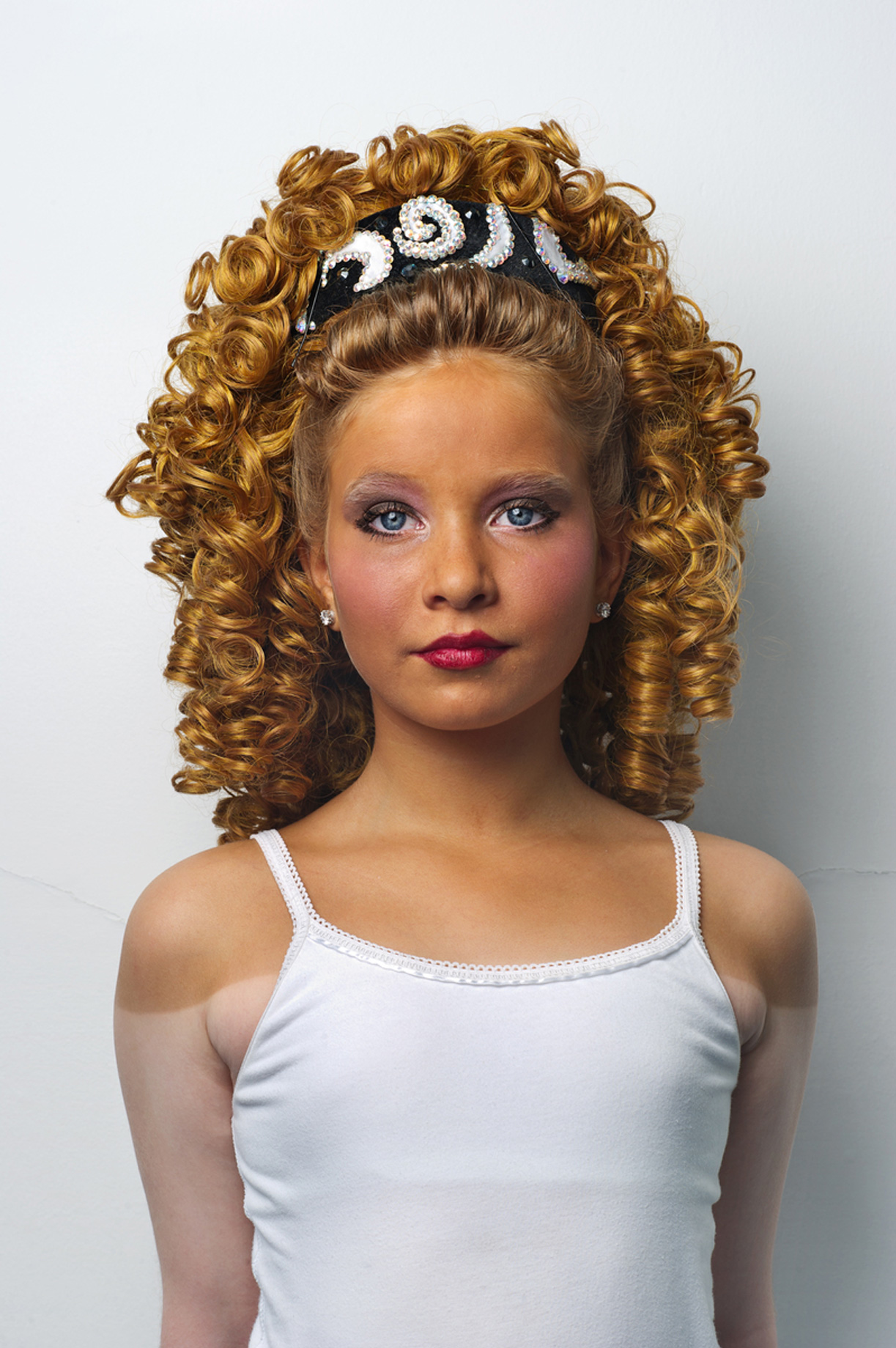
In 1994 during a seven-minute interval at the Eurovision Song Contest in Dublin a group of dancers took to the stage and proceeded to blow the audience away, including millions on television. Fronted by Michael Flatley and Jean Butler, soon to be household names, and accompanied by vibrant and relentless traditionalIrish music, this was the first public performance of the global phenomenon that would become known as Riverdance.
Now fast forward to Belfast in April, 2012. Up to 4,500 competitors took part in the Irish World Dance Championships, an event that began in more humble circumstances in Dublin in 1970 – its aim being to promote Gaelic dance culture. Since then its popularity has gone through the roof with contestants travelling from all over the world to compete.
The show is more than a dance discipline in the strict sense; the ‘look’ is also deemed important and almost an industry it itself. Contestants spray on fake-tan, carefully apply make up, attach wigs and tiaras and sport dresses that in some cases cost up to 4,000 Euro. It is an expensive environment as well as being a highly charged and extremely competitive one.
Why do they spend so much time and money on costume? To catch the judges’ attention is the common explanation. Critics claim it is over-indulgent and garish and has little to do with the reason they are there – to dance, to promote culture. Advocates insist the dance is the most important facet on which contestants are scored and that irrespective of how ornate one’s embroidered dress, these choices are entirely discretionary.
There are no hard rules governing dress sense. But it is widely accepted by those who compete and their families that unless you stand out visually then there is a danger you may be ignored.
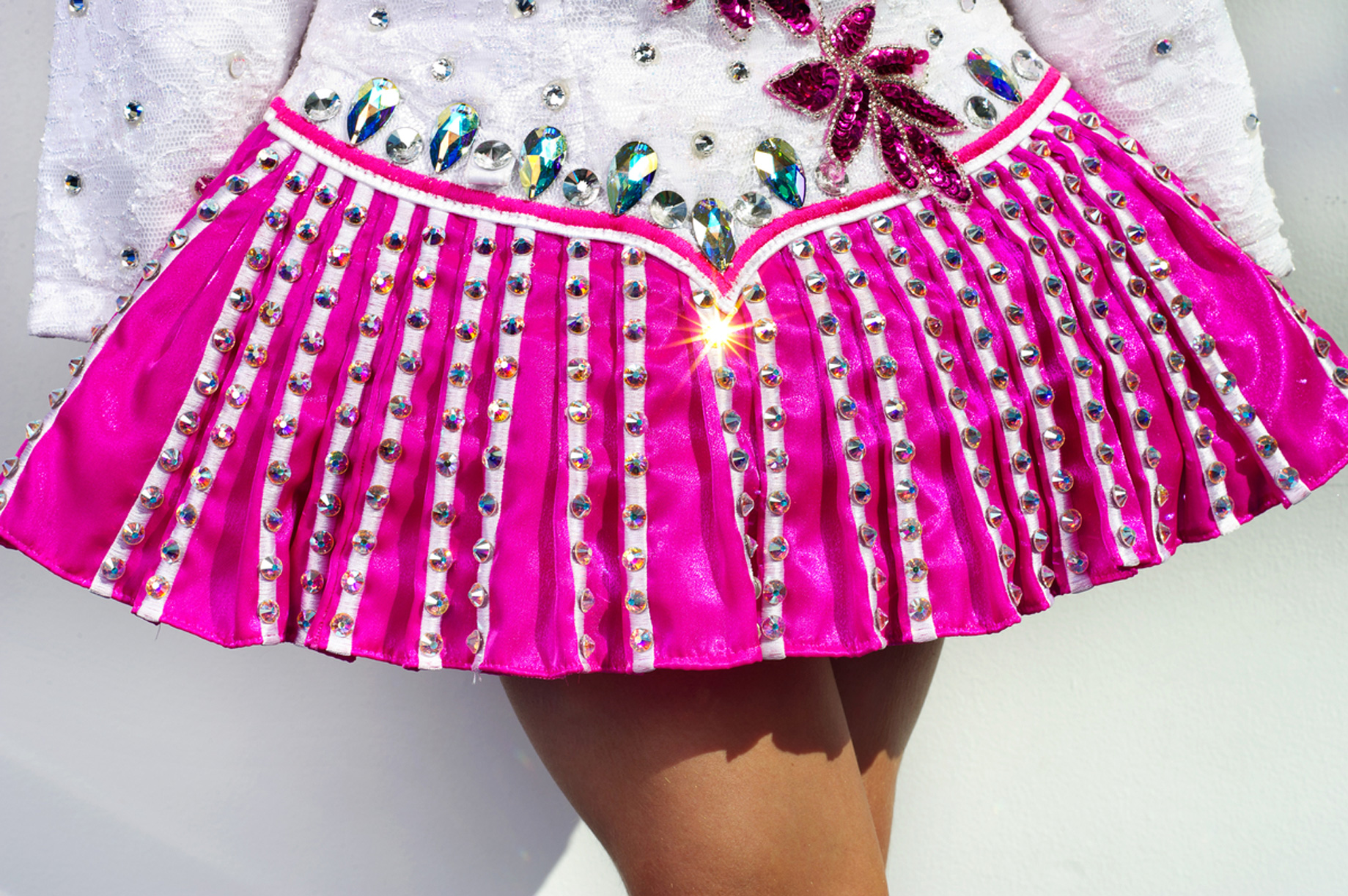
In 1994 during a seven-minute interval at the Eurovision Song Contest in Dublin a group of dancers took to the stage and proceeded to blow the audience away, including millions on television. Fronted by Michael Flatley and Jean Butler, soon to be household names, and accompanied by vibrant and relentless traditionalIrish music, this was the first public performance of the global phenomenon that would become known as Riverdance.
Now fast forward to Belfast in April, 2012. Up to 4,500 competitors took part in the Irish World Dance Championships, an event that began in more humble circumstances in Dublin in 1970 – its aim being to promote Gaelic dance culture. Since then its popularity has gone through the roof with contestants travelling from all over the world to compete.
The show is more than a dance discipline in the strict sense; the ‘look’ is also deemed important and almost an industry it itself. Contestants spray on fake-tan, carefully apply make up, attach wigs and tiaras and sport dresses that in some cases cost up to 4,000 Euro. It is an expensive environment as well as being a highly charged and extremely competitive one.
Why do they spend so much time and money on costume? To catch the judges’ attention is the common explanation. Critics claim it is over-indulgent and garish and has little to do with the reason they are there – to dance, to promote culture. Advocates insist the dance is the most important facet on which contestants are scored and that irrespective of how ornate one’s embroidered dress, these choices are entirely discretionary.
There are no hard rules governing dress sense. But it is widely accepted by those who compete and their families that unless you stand out visually then there is a danger you may be ignored.

In 1994 during a seven-minute interval at the Eurovision Song Contest in Dublin a group of dancers took to the stage and proceeded to blow the audience away, including millions on television. Fronted by Michael Flatley and Jean Butler, soon to be household names, and accompanied by vibrant and relentless traditionalIrish music, this was the first public performance of the global phenomenon that would become known as Riverdance.
Now fast forward to Belfast in April, 2012. Up to 4,500 competitors took part in the Irish World Dance Championships, an event that began in more humble circumstances in Dublin in 1970 – its aim being to promote Gaelic dance culture. Since then its popularity has gone through the roof with contestants travelling from all over the world to compete.
The show is more than a dance discipline in the strict sense; the ‘look’ is also deemed important and almost an industry it itself. Contestants spray on fake-tan, carefully apply make up, attach wigs and tiaras and sport dresses that in some cases cost up to 4,000 Euro. It is an expensive environment as well as being a highly charged and extremely competitive one.
Why do they spend so much time and money on costume? To catch the judges’ attention is the common explanation. Critics claim it is over-indulgent and garish and has little to do with the reason they are there – to dance, to promote culture. Advocates insist the dance is the most important facet on which contestants are scored and that irrespective of how ornate one’s embroidered dress, these choices are entirely discretionary.
There are no hard rules governing dress sense. But it is widely accepted by those who compete and their families that unless you stand out visually then there is a danger you may be ignored.
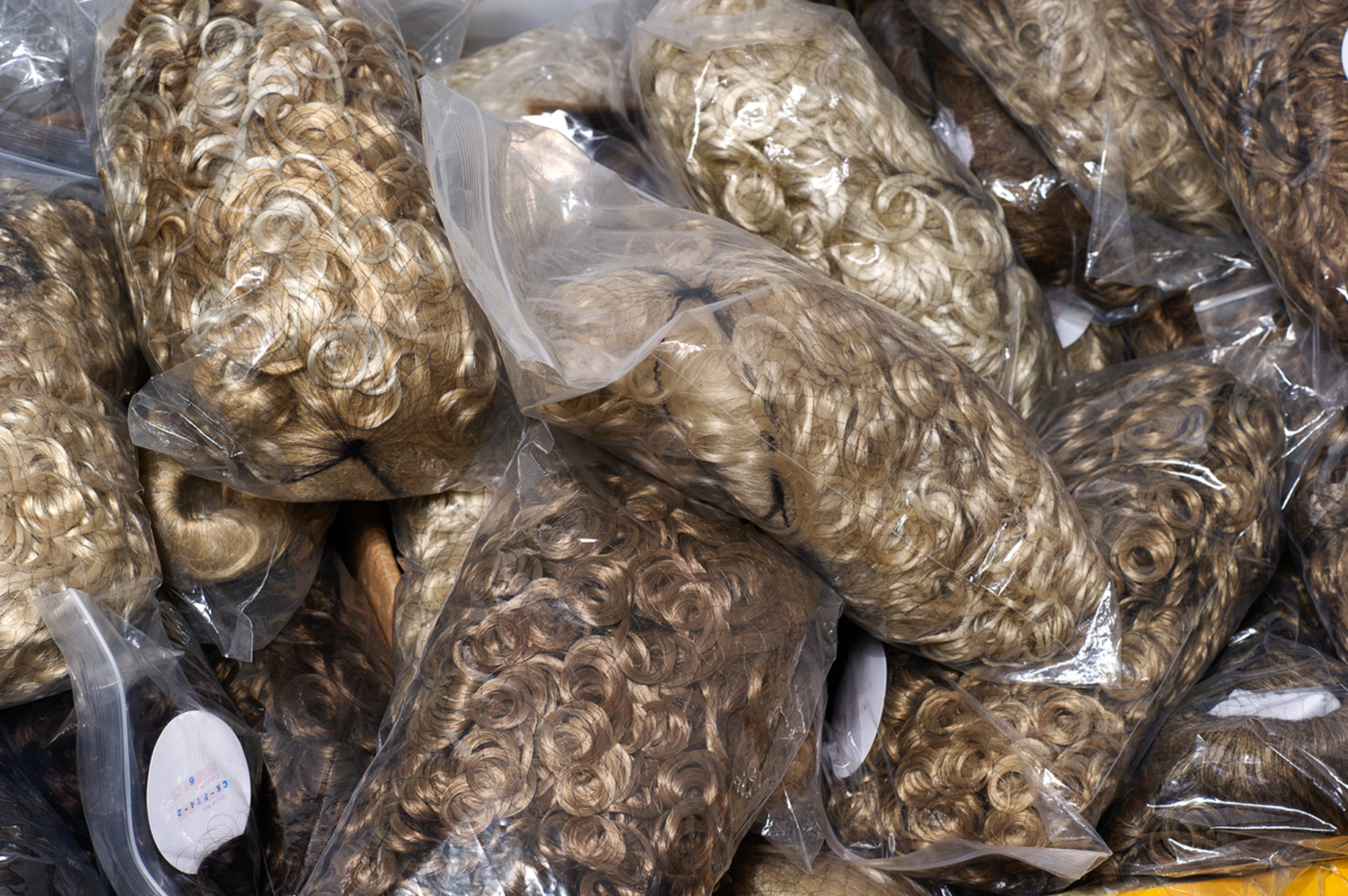
In 1994 during a seven-minute interval at the Eurovision Song Contest in Dublin a group of dancers took to the stage and proceeded to blow the audience away, including millions on television. Fronted by Michael Flatley and Jean Butler, soon to be household names, and accompanied by vibrant and relentless traditionalIrish music, this was the first public performance of the global phenomenon that would become known as Riverdance.
Now fast forward to Belfast in April, 2012. Up to 4,500 competitors took part in the Irish World Dance Championships, an event that began in more humble circumstances in Dublin in 1970 – its aim being to promote Gaelic dance culture. Since then its popularity has gone through the roof with contestants travelling from all over the world to compete.
The show is more than a dance discipline in the strict sense; the ‘look’ is also deemed important and almost an industry it itself. Contestants spray on fake-tan, carefully apply make up, attach wigs and tiaras and sport dresses that in some cases cost up to 4,000 Euro. It is an expensive environment as well as being a highly charged and extremely competitive one.
Why do they spend so much time and money on costume? To catch the judges’ attention is the common explanation. Critics claim it is over-indulgent and garish and has little to do with the reason they are there – to dance, to promote culture. Advocates insist the dance is the most important facet on which contestants are scored and that irrespective of how ornate one’s embroidered dress, these choices are entirely discretionary.
There are no hard rules governing dress sense. But it is widely accepted by those who compete and their families that unless you stand out visually then there is a danger you may be ignored.
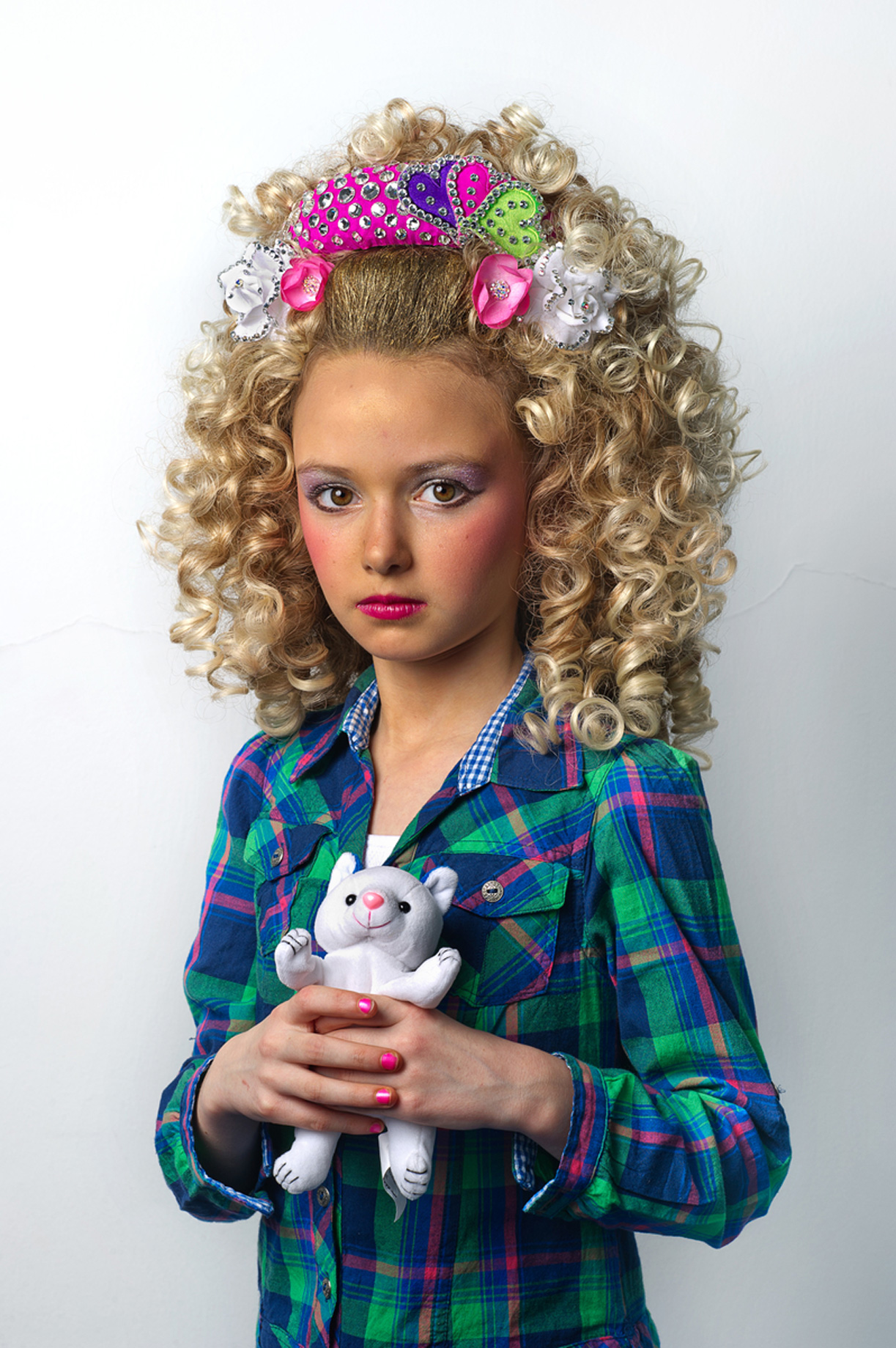
In 1994 during a seven-minute interval at the Eurovision Song Contest in Dublin a group of dancers took to the stage and proceeded to blow the audience away, including millions on television. Fronted by Michael Flatley and Jean Butler, soon to be household names, and accompanied by vibrant and relentless traditionalIrish music, this was the first public performance of the global phenomenon that would become known as Riverdance.
Now fast forward to Belfast in April, 2012. Up to 4,500 competitors took part in the Irish World Dance Championships, an event that began in more humble circumstances in Dublin in 1970 – its aim being to promote Gaelic dance culture. Since then its popularity has gone through the roof with contestants travelling from all over the world to compete.
The show is more than a dance discipline in the strict sense; the ‘look’ is also deemed important and almost an industry it itself. Contestants spray on fake-tan, carefully apply make up, attach wigs and tiaras and sport dresses that in some cases cost up to 4,000 Euro. It is an expensive environment as well as being a highly charged and extremely competitive one.
Why do they spend so much time and money on costume? To catch the judges’ attention is the common explanation. Critics claim it is over-indulgent and garish and has little to do with the reason they are there – to dance, to promote culture. Advocates insist the dance is the most important facet on which contestants are scored and that irrespective of how ornate one’s embroidered dress, these choices are entirely discretionary.
There are no hard rules governing dress sense. But it is widely accepted by those who compete and their families that unless you stand out visually then there is a danger you may be ignored.

In 1994 during a seven-minute interval at the Eurovision Song Contest in Dublin a group of dancers took to the stage and proceeded to blow the audience away, including millions on television. Fronted by Michael Flatley and Jean Butler, soon to be household names, and accompanied by vibrant and relentless traditionalIrish music, this was the first public performance of the global phenomenon that would become known as Riverdance.
Now fast forward to Belfast in April, 2012. Up to 4,500 competitors took part in the Irish World Dance Championships, an event that began in more humble circumstances in Dublin in 1970 – its aim being to promote Gaelic dance culture. Since then its popularity has gone through the roof with contestants travelling from all over the world to compete.
The show is more than a dance discipline in the strict sense; the ‘look’ is also deemed important and almost an industry it itself. Contestants spray on fake-tan, carefully apply make up, attach wigs and tiaras and sport dresses that in some cases cost up to 4,000 Euro. It is an expensive environment as well as being a highly charged and extremely competitive one.
Why do they spend so much time and money on costume? To catch the judges’ attention is the common explanation. Critics claim it is over-indulgent and garish and has little to do with the reason they are there – to dance, to promote culture. Advocates insist the dance is the most important facet on which contestants are scored and that irrespective of how ornate one’s embroidered dress, these choices are entirely discretionary.
There are no hard rules governing dress sense. But it is widely accepted by those who compete and their families that unless you stand out visually then there is a danger you may be ignored.

In 1994 during a seven-minute interval at the Eurovision Song Contest in Dublin a group of dancers took to the stage and proceeded to blow the audience away, including millions on television. Fronted by Michael Flatley and Jean Butler, soon to be household names, and accompanied by vibrant and relentless traditionalIrish music, this was the first public performance of the global phenomenon that would become known as Riverdance.
Now fast forward to Belfast in April, 2012. Up to 4,500 competitors took part in the Irish World Dance Championships, an event that began in more humble circumstances in Dublin in 1970 – its aim being to promote Gaelic dance culture. Since then its popularity has gone through the roof with contestants travelling from all over the world to compete.
The show is more than a dance discipline in the strict sense; the ‘look’ is also deemed important and almost an industry it itself. Contestants spray on fake-tan, carefully apply make up, attach wigs and tiaras and sport dresses that in some cases cost up to 4,000 Euro. It is an expensive environment as well as being a highly charged and extremely competitive one.
Why do they spend so much time and money on costume? To catch the judges’ attention is the common explanation. Critics claim it is over-indulgent and garish and has little to do with the reason they are there – to dance, to promote culture. Advocates insist the dance is the most important facet on which contestants are scored and that irrespective of how ornate one’s embroidered dress, these choices are entirely discretionary.
There are no hard rules governing dress sense. But it is widely accepted by those who compete and their families that unless you stand out visually then there is a danger you may be ignored.
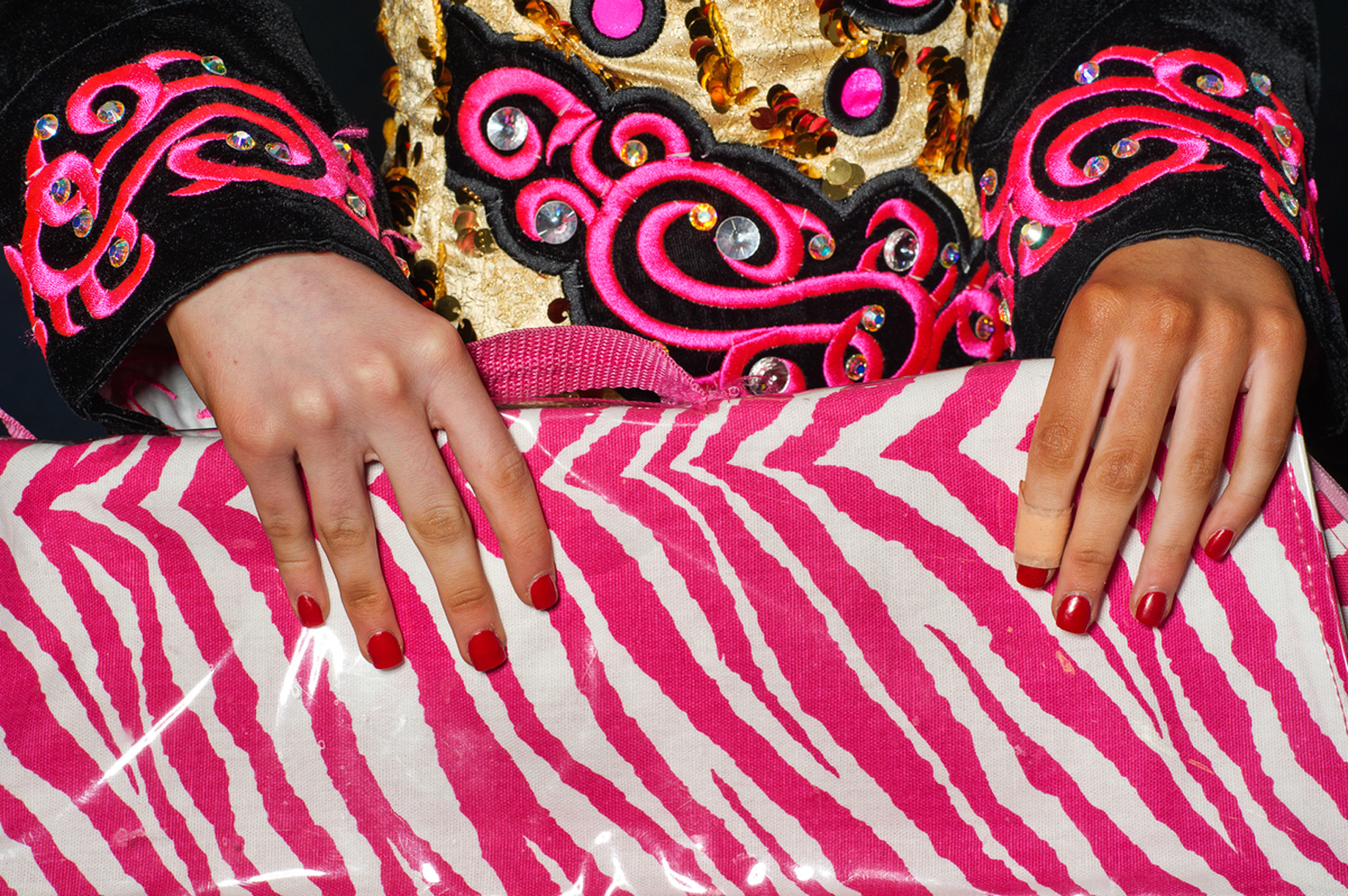
In 1994 during a seven-minute interval at the Eurovision Song Contest in Dublin a group of dancers took to the stage and proceeded to blow the audience away, including millions on television. Fronted by Michael Flatley and Jean Butler, soon to be household names, and accompanied by vibrant and relentless traditionalIrish music, this was the first public performance of the global phenomenon that would become known as Riverdance.
Now fast forward to Belfast in April, 2012. Up to 4,500 competitors took part in the Irish World Dance Championships, an event that began in more humble circumstances in Dublin in 1970 – its aim being to promote Gaelic dance culture. Since then its popularity has gone through the roof with contestants travelling from all over the world to compete.
The show is more than a dance discipline in the strict sense; the ‘look’ is also deemed important and almost an industry it itself. Contestants spray on fake-tan, carefully apply make up, attach wigs and tiaras and sport dresses that in some cases cost up to 4,000 Euro. It is an expensive environment as well as being a highly charged and extremely competitive one.
Why do they spend so much time and money on costume? To catch the judges’ attention is the common explanation. Critics claim it is over-indulgent and garish and has little to do with the reason they are there – to dance, to promote culture. Advocates insist the dance is the most important facet on which contestants are scored and that irrespective of how ornate one’s embroidered dress, these choices are entirely discretionary.
There are no hard rules governing dress sense. But it is widely accepted by those who compete and their families that unless you stand out visually then there is a danger you may be ignored.
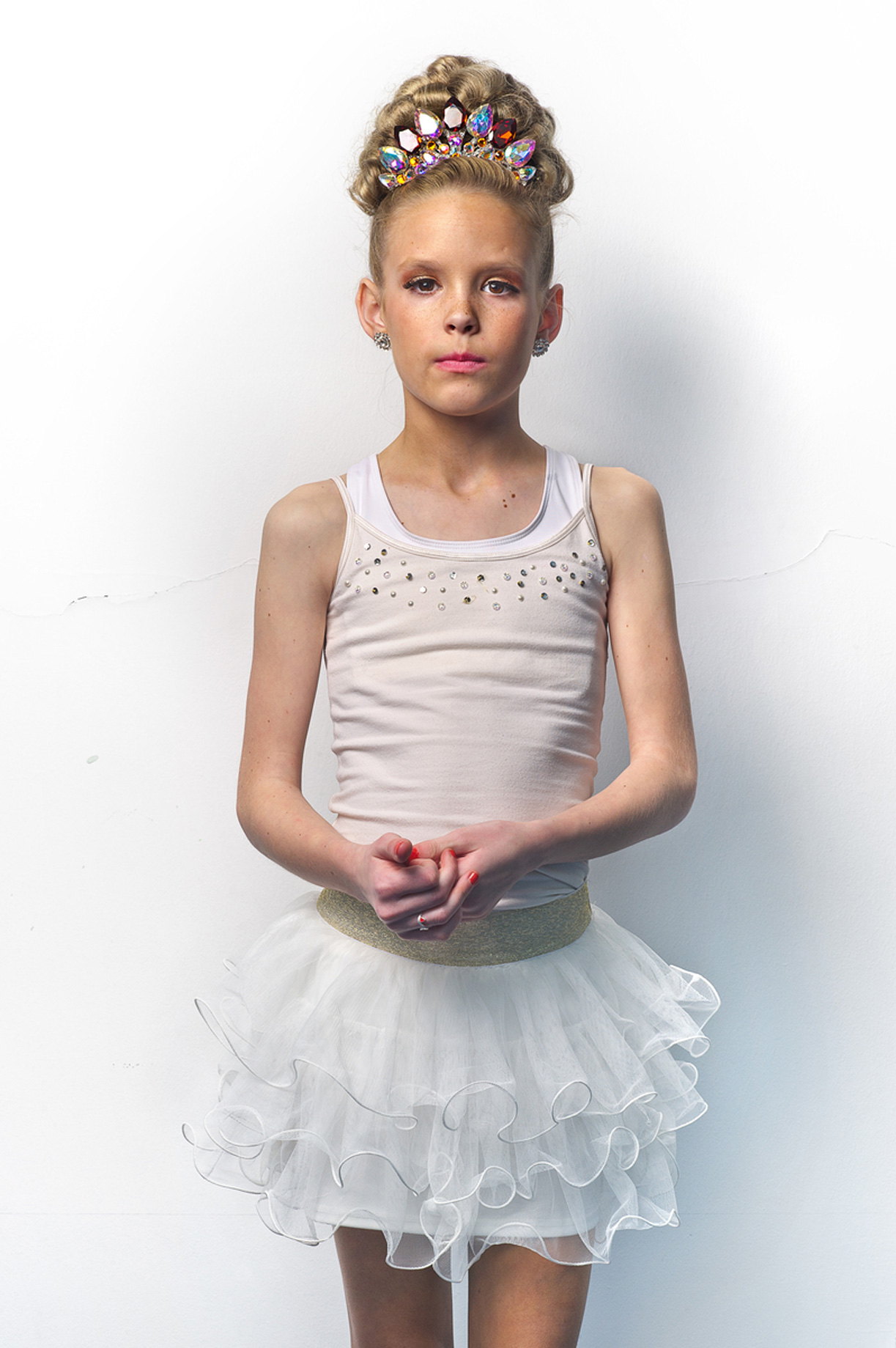
In 1994 during a seven-minute interval at the Eurovision Song Contest in Dublin a group of dancers took to the stage and proceeded to blow the audience away, including millions on television. Fronted by Michael Flatley and Jean Butler, soon to be household names, and accompanied by vibrant and relentless traditionalIrish music, this was the first public performance of the global phenomenon that would become known as Riverdance.
Now fast forward to Belfast in April, 2012. Up to 4,500 competitors took part in the Irish World Dance Championships, an event that began in more humble circumstances in Dublin in 1970 – its aim being to promote Gaelic dance culture. Since then its popularity has gone through the roof with contestants travelling from all over the world to compete.
The show is more than a dance discipline in the strict sense; the ‘look’ is also deemed important and almost an industry it itself. Contestants spray on fake-tan, carefully apply make up, attach wigs and tiaras and sport dresses that in some cases cost up to 4,000 Euro. It is an expensive environment as well as being a highly charged and extremely competitive one.
Why do they spend so much time and money on costume? To catch the judges’ attention is the common explanation. Critics claim it is over-indulgent and garish and has little to do with the reason they are there – to dance, to promote culture. Advocates insist the dance is the most important facet on which contestants are scored and that irrespective of how ornate one’s embroidered dress, these choices are entirely discretionary.
There are no hard rules governing dress sense. But it is widely accepted by those who compete and their families that unless you stand out visually then there is a danger you may be ignored.
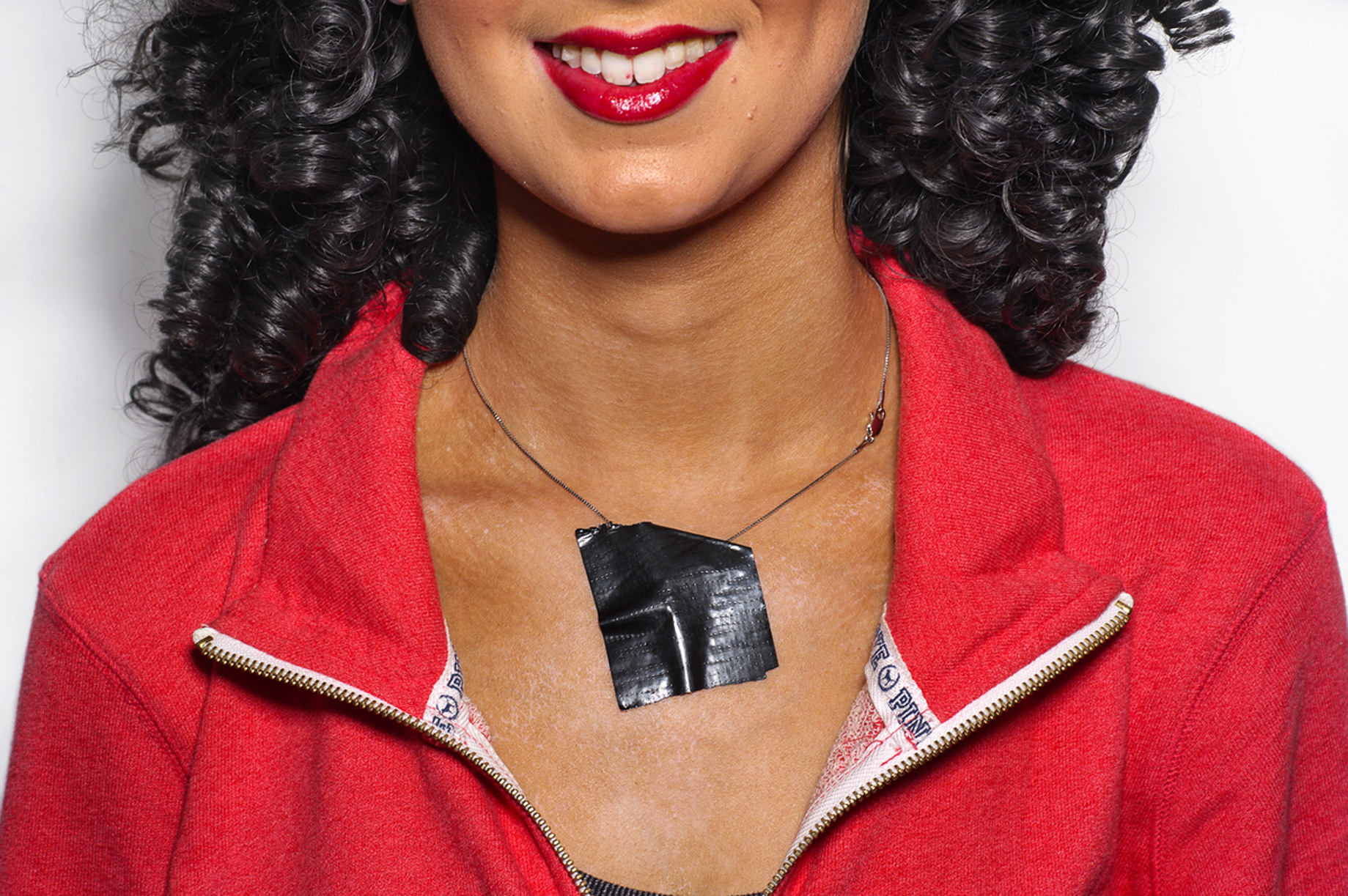
In 1994 during a seven-minute interval at the Eurovision Song Contest in Dublin a group of dancers took to the stage and proceeded to blow the audience away, including millions on television. Fronted by Michael Flatley and Jean Butler, soon to be household names, and accompanied by vibrant and relentless traditionalIrish music, this was the first public performance of the global phenomenon that would become known as Riverdance.
Now fast forward to Belfast in April, 2012. Up to 4,500 competitors took part in the Irish World Dance Championships, an event that began in more humble circumstances in Dublin in 1970 – its aim being to promote Gaelic dance culture. Since then its popularity has gone through the roof with contestants travelling from all over the world to compete.
The show is more than a dance discipline in the strict sense; the ‘look’ is also deemed important and almost an industry it itself. Contestants spray on fake-tan, carefully apply make up, attach wigs and tiaras and sport dresses that in some cases cost up to 4,000 Euro. It is an expensive environment as well as being a highly charged and extremely competitive one.
Why do they spend so much time and money on costume? To catch the judges’ attention is the common explanation. Critics claim it is over-indulgent and garish and has little to do with the reason they are there – to dance, to promote culture. Advocates insist the dance is the most important facet on which contestants are scored and that irrespective of how ornate one’s embroidered dress, these choices are entirely discretionary.
There are no hard rules governing dress sense. But it is widely accepted by those who compete and their families that unless you stand out visually then there is a danger you may be ignored.
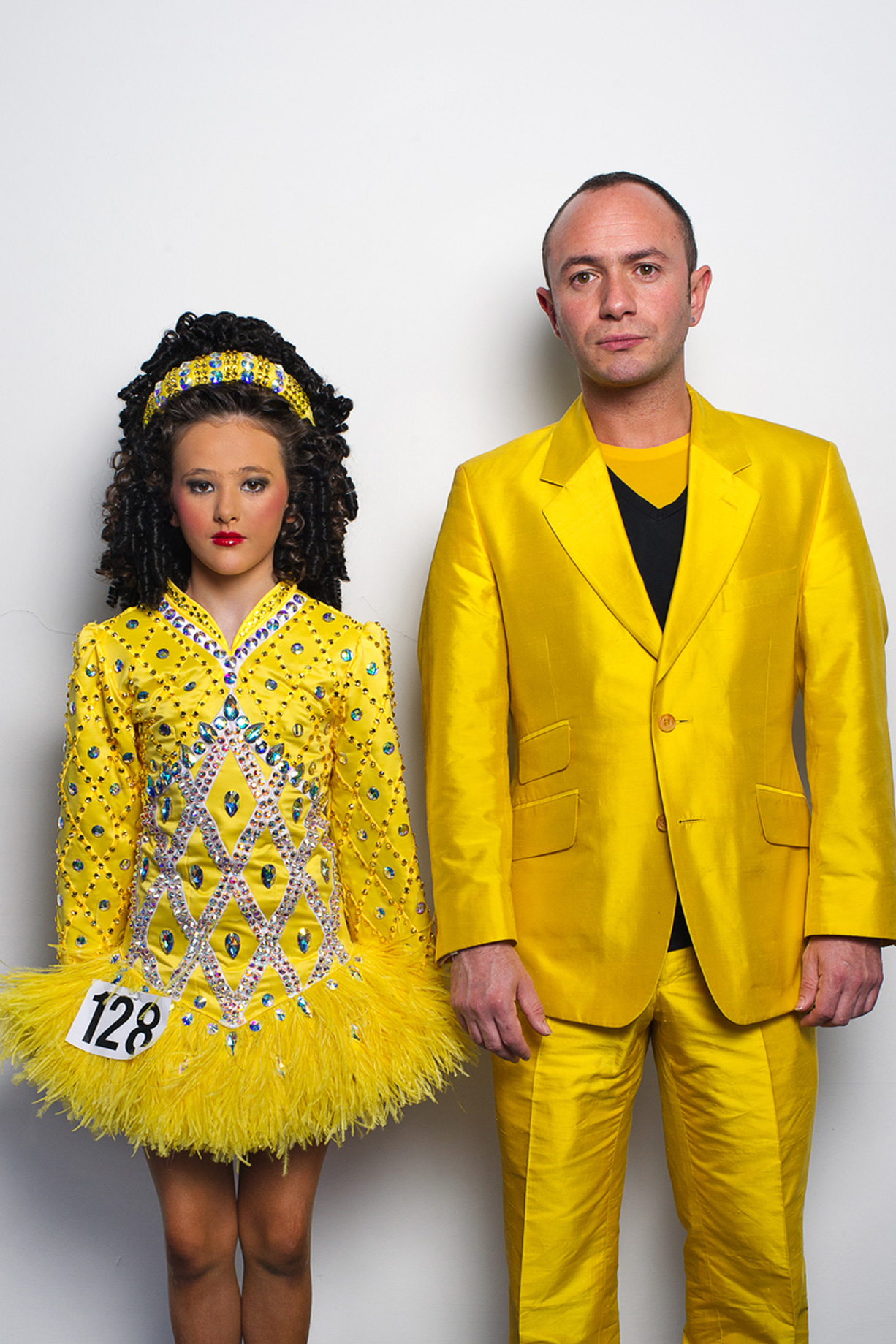
In 1994 during a seven-minute interval at the Eurovision Song Contest in Dublin a group of dancers took to the stage and proceeded to blow the audience away, including millions on television. Fronted by Michael Flatley and Jean Butler, soon to be household names, and accompanied by vibrant and relentless traditionalIrish music, this was the first public performance of the global phenomenon that would become known as Riverdance.
Now fast forward to Belfast in April, 2012. Up to 4,500 competitors took part in the Irish World Dance Championships, an event that began in more humble circumstances in Dublin in 1970 – its aim being to promote Gaelic dance culture. Since then its popularity has gone through the roof with contestants travelling from all over the world to compete.
The show is more than a dance discipline in the strict sense; the ‘look’ is also deemed important and almost an industry it itself. Contestants spray on fake-tan, carefully apply make up, attach wigs and tiaras and sport dresses that in some cases cost up to 4,000 Euro. It is an expensive environment as well as being a highly charged and extremely competitive one.
Why do they spend so much time and money on costume? To catch the judges’ attention is the common explanation. Critics claim it is over-indulgent and garish and has little to do with the reason they are there – to dance, to promote culture. Advocates insist the dance is the most important facet on which contestants are scored and that irrespective of how ornate one’s embroidered dress, these choices are entirely discretionary.
There are no hard rules governing dress sense. But it is widely accepted by those who compete and their families that unless you stand out visually then there is a danger you may be ignored.
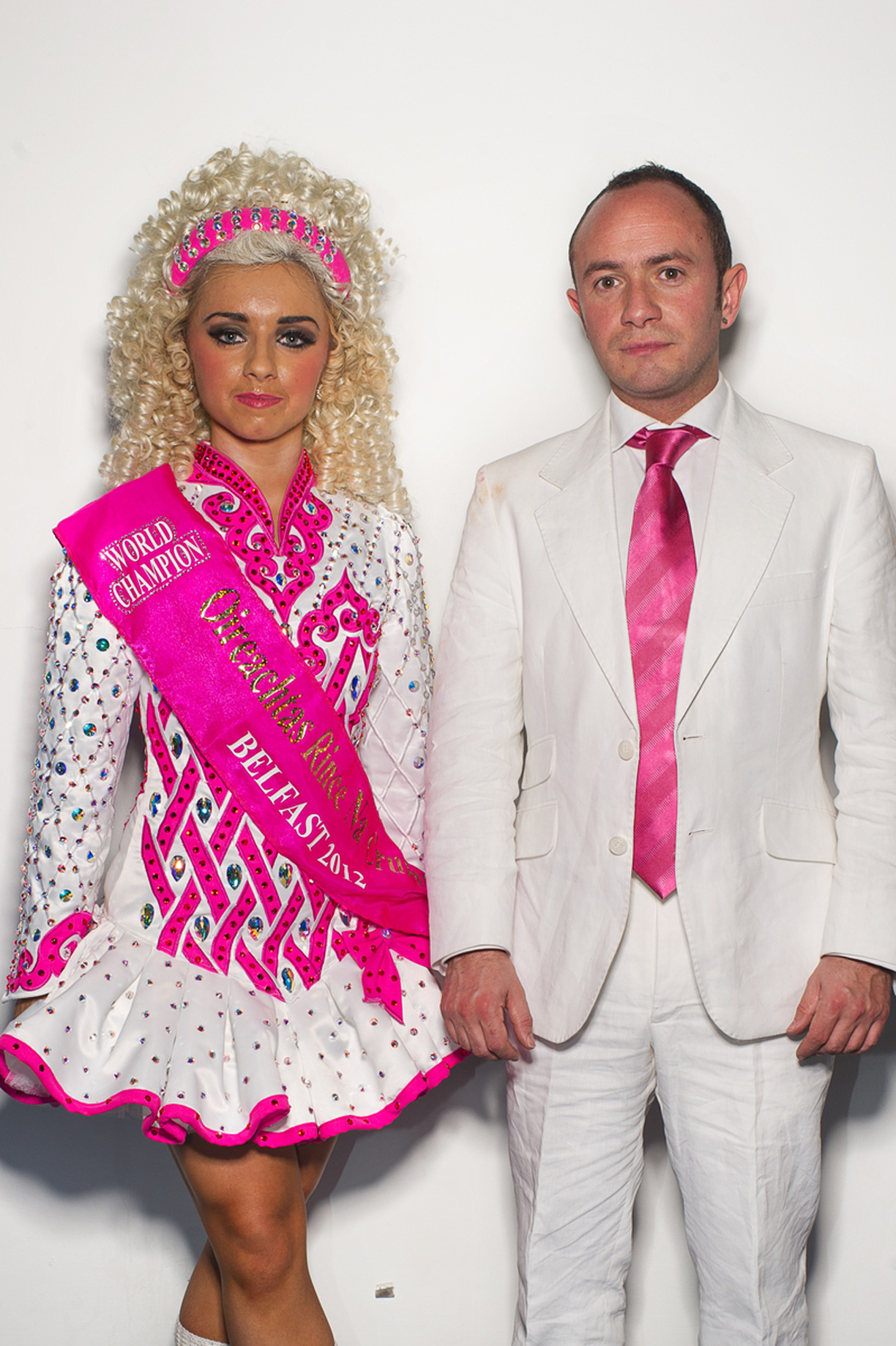
In 1994 during a seven-minute interval at the Eurovision Song Contest in Dublin a group of dancers took to the stage and proceeded to blow the audience away, including millions on television. Fronted by Michael Flatley and Jean Butler, soon to be household names, and accompanied by vibrant and relentless traditionalIrish music, this was the first public performance of the global phenomenon that would become known as Riverdance.
Now fast forward to Belfast in April, 2012. Up to 4,500 competitors took part in the Irish World Dance Championships, an event that began in more humble circumstances in Dublin in 1970 – its aim being to promote Gaelic dance culture. Since then its popularity has gone through the roof with contestants travelling from all over the world to compete.
The show is more than a dance discipline in the strict sense; the ‘look’ is also deemed important and almost an industry it itself. Contestants spray on fake-tan, carefully apply make up, attach wigs and tiaras and sport dresses that in some cases cost up to 4,000 Euro. It is an expensive environment as well as being a highly charged and extremely competitive one.
Why do they spend so much time and money on costume? To catch the judges’ attention is the common explanation. Critics claim it is over-indulgent and garish and has little to do with the reason they are there – to dance, to promote culture. Advocates insist the dance is the most important facet on which contestants are scored and that irrespective of how ornate one’s embroidered dress, these choices are entirely discretionary.
There are no hard rules governing dress sense. But it is widely accepted by those who compete and their families that unless you stand out visually then there is a danger you may be ignored.
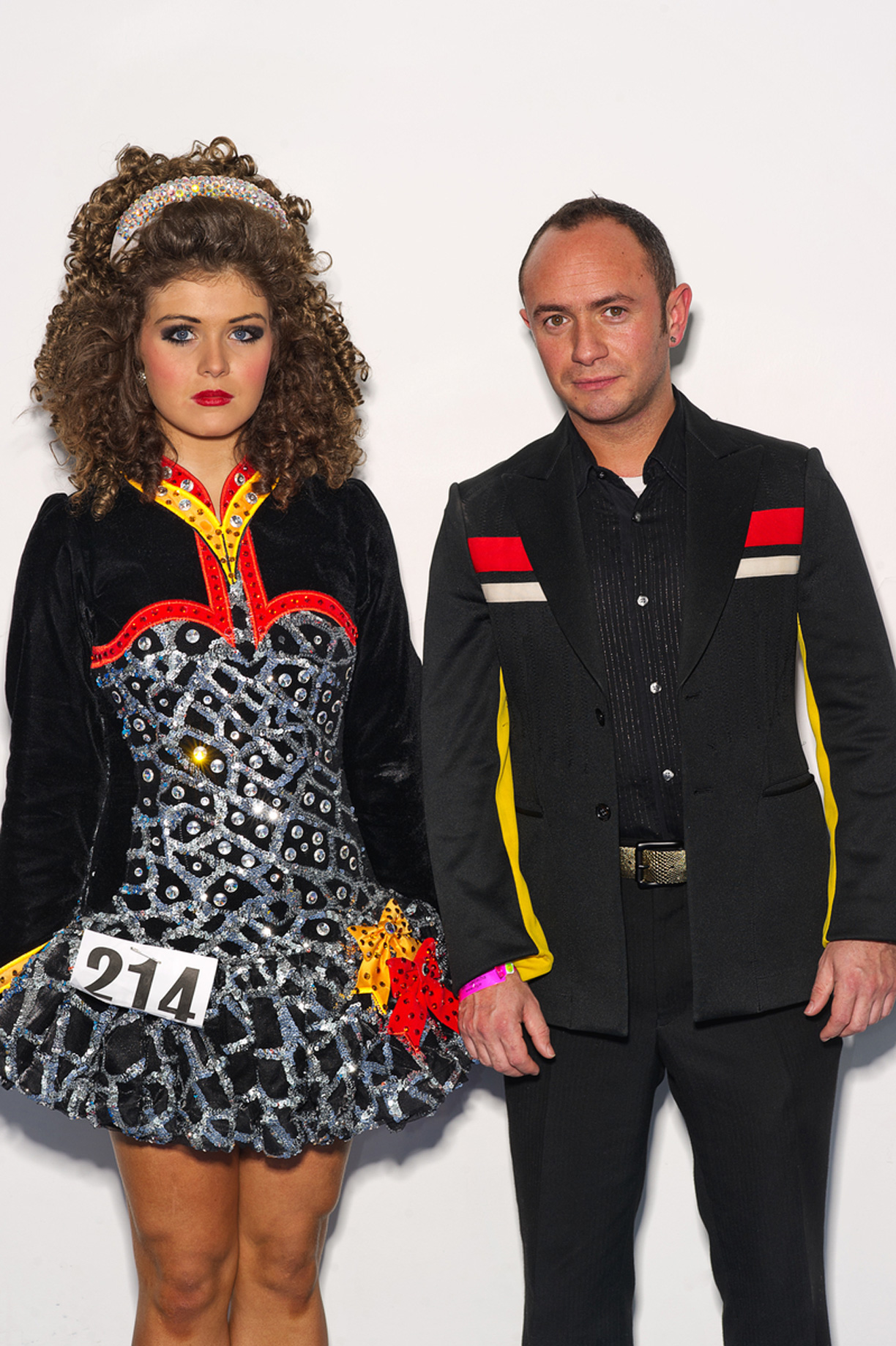
In 1994 during a seven-minute interval at the Eurovision Song Contest in Dublin a group of dancers took to the stage and proceeded to blow the audience away, including millions on television. Fronted by Michael Flatley and Jean Butler, soon to be household names, and accompanied by vibrant and relentless traditionalIrish music, this was the first public performance of the global phenomenon that would become known as Riverdance.
Now fast forward to Belfast in April, 2012. Up to 4,500 competitors took part in the Irish World Dance Championships, an event that began in more humble circumstances in Dublin in 1970 – its aim being to promote Gaelic dance culture. Since then its popularity has gone through the roof with contestants travelling from all over the world to compete.
The show is more than a dance discipline in the strict sense; the ‘look’ is also deemed important and almost an industry it itself. Contestants spray on fake-tan, carefully apply make up, attach wigs and tiaras and sport dresses that in some cases cost up to 4,000 Euro. It is an expensive environment as well as being a highly charged and extremely competitive one.
Why do they spend so much time and money on costume? To catch the judges’ attention is the common explanation. Critics claim it is over-indulgent and garish and has little to do with the reason they are there – to dance, to promote culture. Advocates insist the dance is the most important facet on which contestants are scored and that irrespective of how ornate one’s embroidered dress, these choices are entirely discretionary.
There are no hard rules governing dress sense. But it is widely accepted by those who compete and their families that unless you stand out visually then there is a danger you may be ignored.
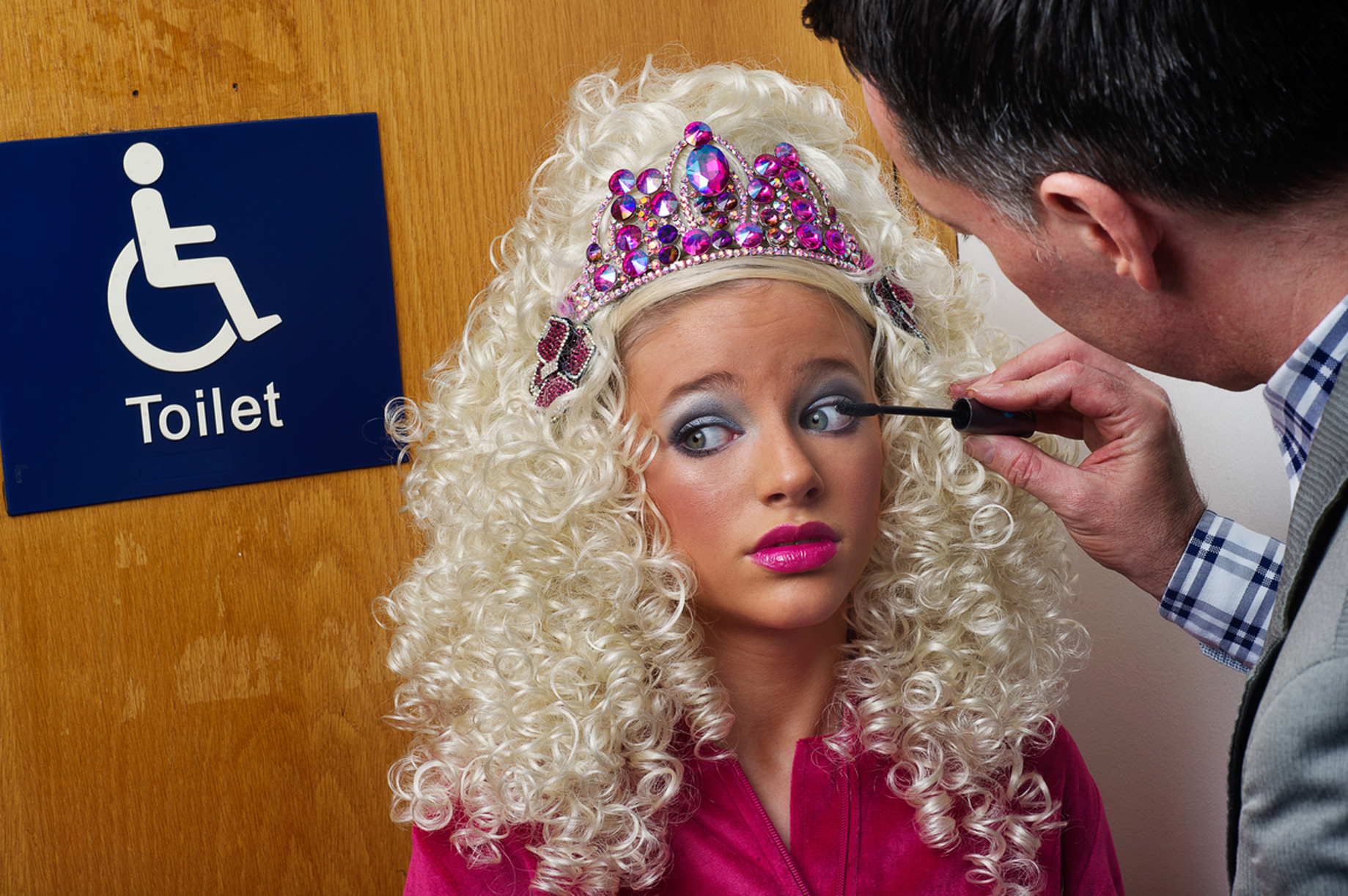
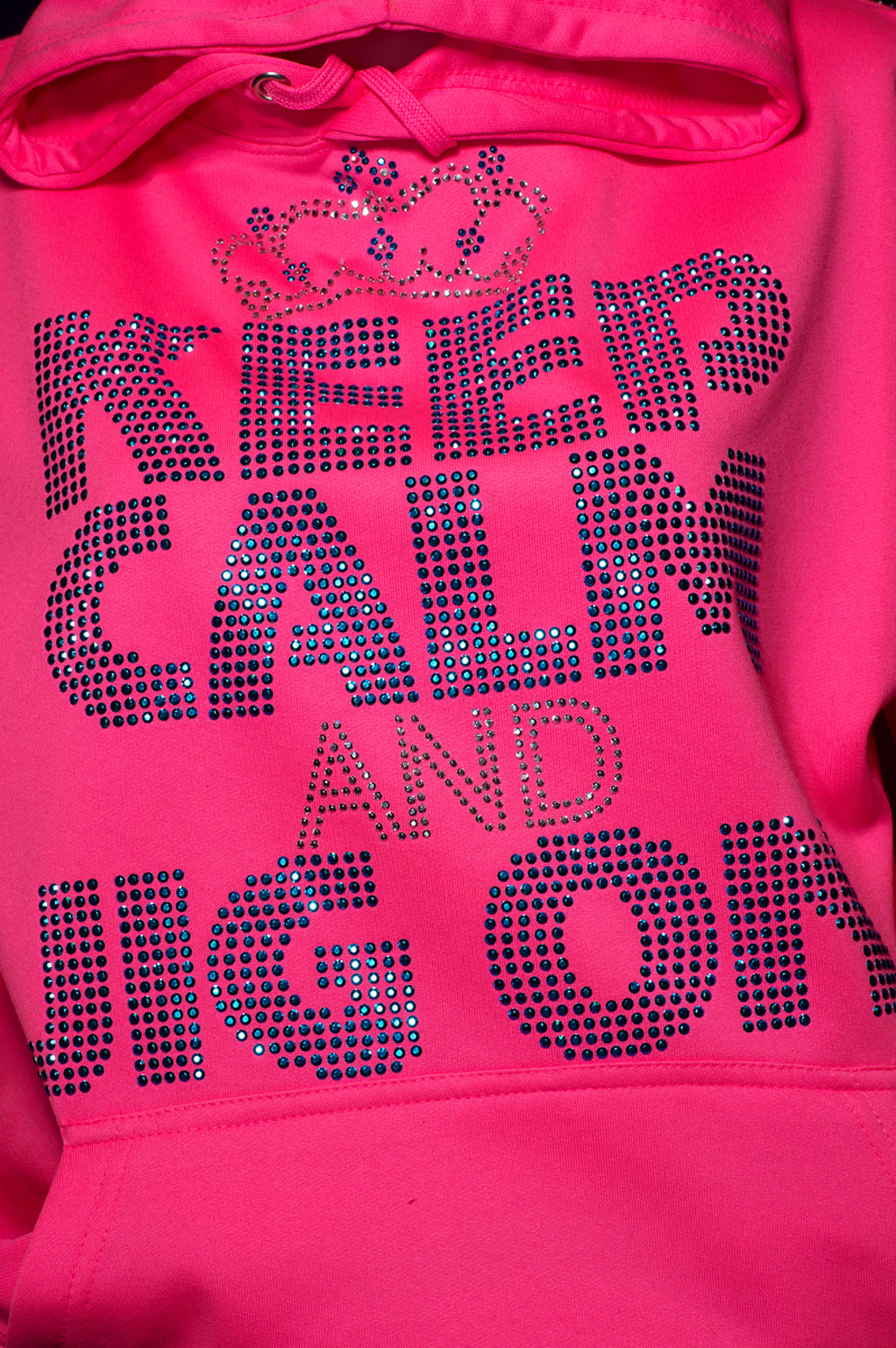
In 1994 during a seven-minute interval at the Eurovision Song Contest in Dublin a group of dancers took to the stage and proceeded to blow the audience away, including millions on television. Fronted by Michael Flatley and Jean Butler, soon to be household names, and accompanied by vibrant and relentless traditionalIrish music, this was the first public performance of the global phenomenon that would become known as Riverdance.
Now fast forward to Belfast in April, 2012. Up to 4,500 competitors took part in the Irish World Dance Championships, an event that began in more humble circumstances in Dublin in 1970 – its aim being to promote Gaelic dance culture. Since then its popularity has gone through the roof with contestants travelling from all over the world to compete.
The show is more than a dance discipline in the strict sense; the ‘look’ is also deemed important and almost an industry it itself. Contestants spray on fake-tan, carefully apply make up, attach wigs and tiaras and sport dresses that in some cases cost up to 4,000 Euro. It is an expensive environment as well as being a highly charged and extremely competitive one.
Why do they spend so much time and money on costume? To catch the judges’ attention is the common explanation. Critics claim it is over-indulgent and garish and has little to do with the reason they are there – to dance, to promote culture. Advocates insist the dance is the most important facet on which contestants are scored and that irrespective of how ornate one’s embroidered dress, these choices are entirely discretionary.
There are no hard rules governing dress sense. But it is widely accepted by those who compete and their families that unless you stand out visually then there is a danger you may be ignored.
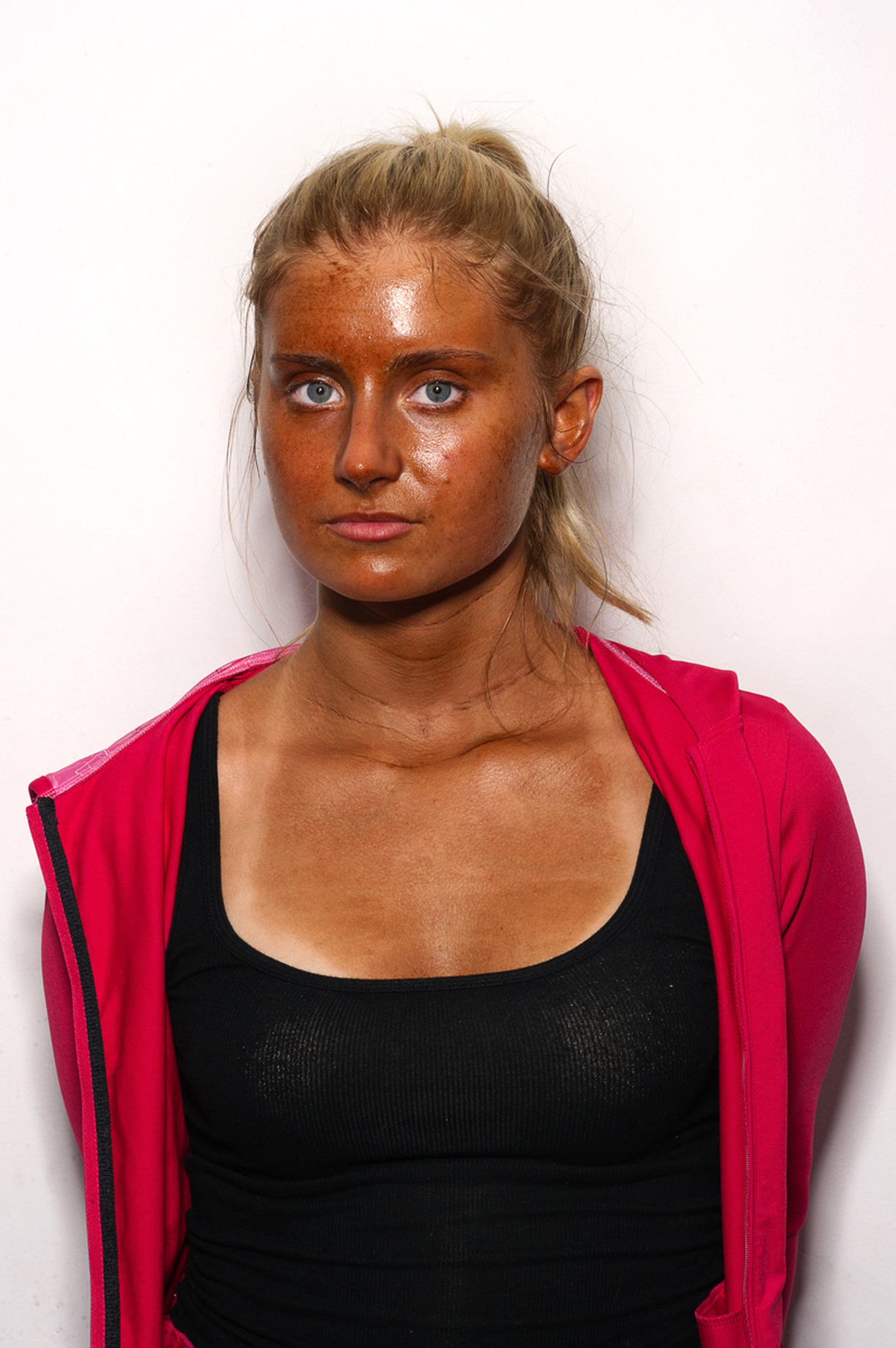
In 1994 during a seven-minute interval at the Eurovision Song Contest in Dublin a group of dancers took to the stage and proceeded to blow the audience away, including millions on television. Fronted by Michael Flatley and Jean Butler, soon to be household names, and accompanied by vibrant and relentless traditionalIrish music, this was the first public performance of the global phenomenon that would become known as Riverdance.
Now fast forward to Belfast in April, 2012. Up to 4,500 competitors took part in the Irish World Dance Championships, an event that began in more humble circumstances in Dublin in 1970 – its aim being to promote Gaelic dance culture. Since then its popularity has gone through the roof with contestants travelling from all over the world to compete.
The show is more than a dance discipline in the strict sense; the ‘look’ is also deemed important and almost an industry it itself. Contestants spray on fake-tan, carefully apply make up, attach wigs and tiaras and sport dresses that in some cases cost up to 4,000 Euro. It is an expensive environment as well as being a highly charged and extremely competitive one.
Why do they spend so much time and money on costume? To catch the judges’ attention is the common explanation. Critics claim it is over-indulgent and garish and has little to do with the reason they are there – to dance, to promote culture. Advocates insist the dance is the most important facet on which contestants are scored and that irrespective of how ornate one’s embroidered dress, these choices are entirely discretionary.
There are no hard rules governing dress sense. But it is widely accepted by those who compete and their families that unless you stand out visually then there is a danger you may be ignored.
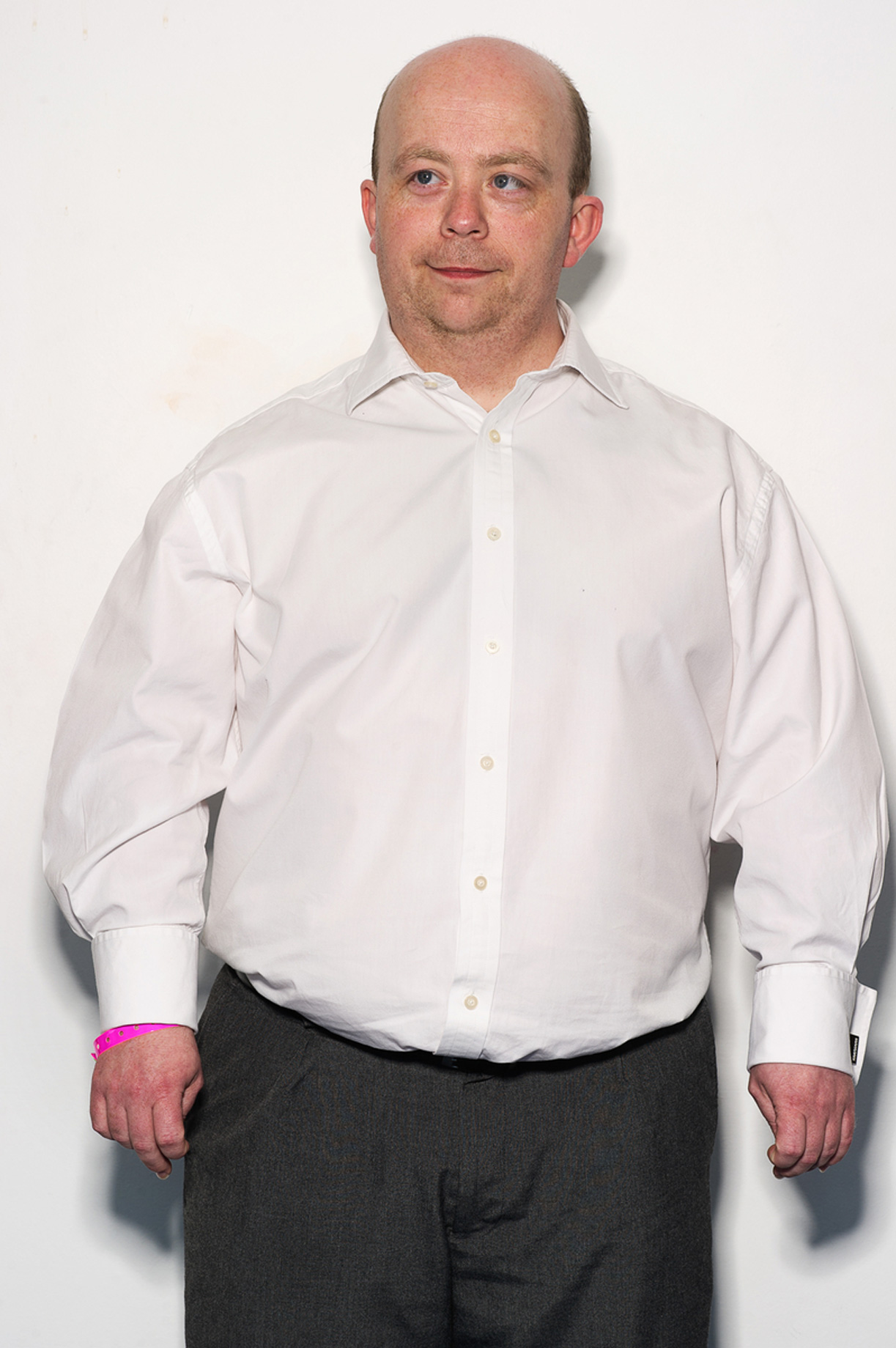
In 1994 during a seven-minute interval at the Eurovision Song Contest in Dublin a group of dancers took to the stage and proceeded to blow the audience away, including millions on television. Fronted by Michael Flatley and Jean Butler, soon to be household names, and accompanied by vibrant and relentless traditionalIrish music, this was the first public performance of the global phenomenon that would become known as Riverdance.
Now fast forward to Belfast in April, 2012. Up to 4,500 competitors took part in the Irish World Dance Championships, an event that began in more humble circumstances in Dublin in 1970 – its aim being to promote Gaelic dance culture. Since then its popularity has gone through the roof with contestants travelling from all over the world to compete.
The show is more than a dance discipline in the strict sense; the ‘look’ is also deemed important and almost an industry it itself. Contestants spray on fake-tan, carefully apply make up, attach wigs and tiaras and sport dresses that in some cases cost up to 4,000 Euro. It is an expensive environment as well as being a highly charged and extremely competitive one.
Why do they spend so much time and money on costume? To catch the judges’ attention is the common explanation. Critics claim it is over-indulgent and garish and has little to do with the reason they are there – to dance, to promote culture. Advocates insist the dance is the most important facet on which contestants are scored and that irrespective of how ornate one’s embroidered dress, these choices are entirely discretionary.
There are no hard rules governing dress sense. But it is widely accepted by those who compete and their families that unless you stand out visually then there is a danger you may be ignored.
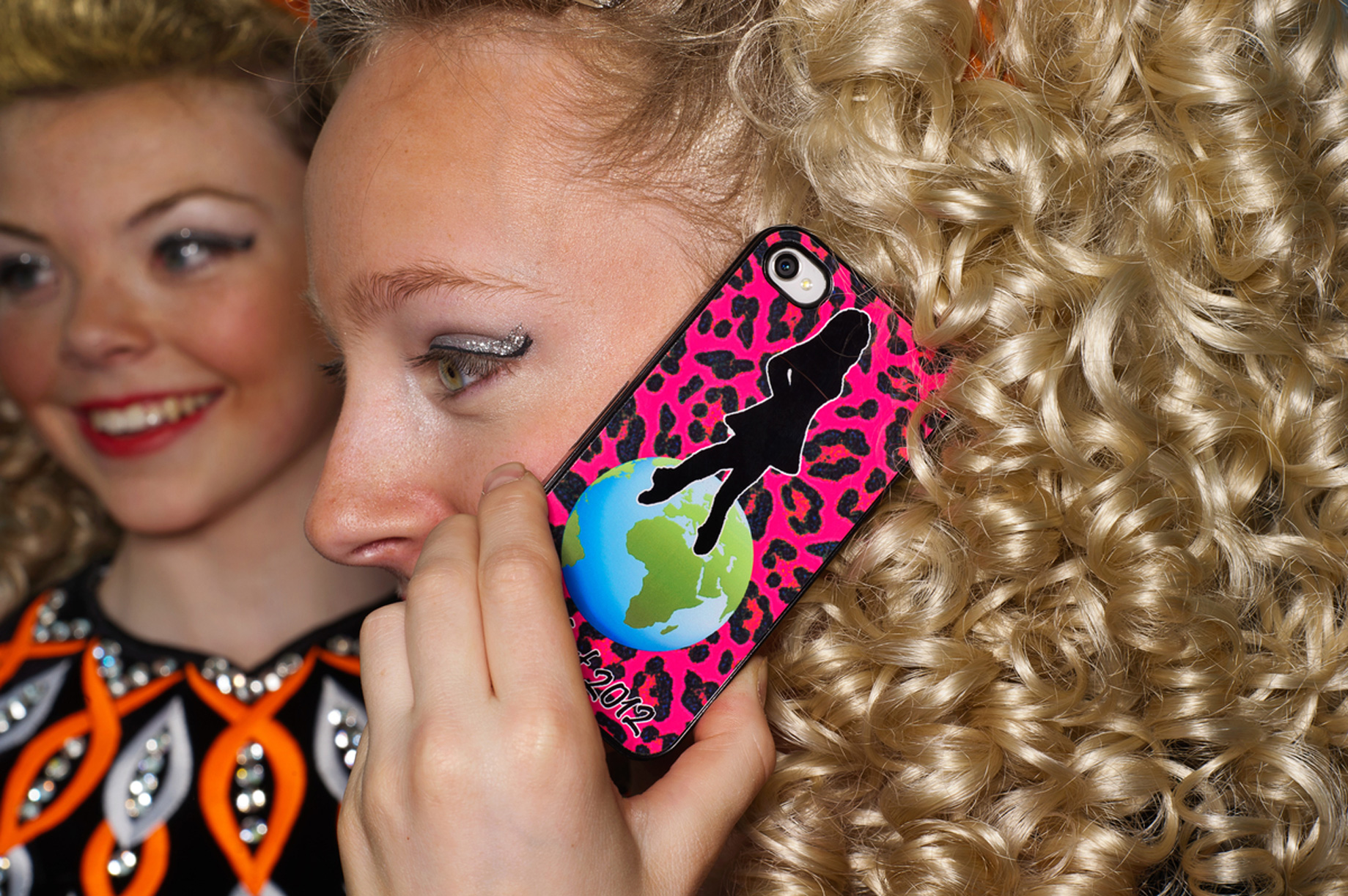
In 1994 during a seven-minute interval at the Eurovision Song Contest in Dublin a group of dancers took to the stage and proceeded to blow the audience away, including millions on television. Fronted by Michael Flatley and Jean Butler, soon to be household names, and accompanied by vibrant and relentless traditionalIrish music, this was the first public performance of the global phenomenon that would become known as Riverdance.
Now fast forward to Belfast in April, 2012. Up to 4,500 competitors took part in the Irish World Dance Championships, an event that began in more humble circumstances in Dublin in 1970 – its aim being to promote Gaelic dance culture. Since then its popularity has gone through the roof with contestants travelling from all over the world to compete.
The show is more than a dance discipline in the strict sense; the ‘look’ is also deemed important and almost an industry it itself. Contestants spray on fake-tan, carefully apply make up, attach wigs and tiaras and sport dresses that in some cases cost up to 4,000 Euro. It is an expensive environment as well as being a highly charged and extremely competitive one.
Why do they spend so much time and money on costume? To catch the judges’ attention is the common explanation. Critics claim it is over-indulgent and garish and has little to do with the reason they are there – to dance, to promote culture. Advocates insist the dance is the most important facet on which contestants are scored and that irrespective of how ornate one’s embroidered dress, these choices are entirely discretionary.
There are no hard rules governing dress sense. But it is widely accepted by those who compete and their families that unless you stand out visually then there is a danger you may be ignored.

In 1994 during a seven-minute interval at the Eurovision Song Contest in Dublin a group of dancers took to the stage and proceeded to blow the audience away, including millions on television. Fronted by Michael Flatley and Jean Butler, soon to be household names, and accompanied by vibrant and relentless traditionalIrish music, this was the first public performance of the global phenomenon that would become known as Riverdance.
Now fast forward to Belfast in April, 2012. Up to 4,500 competitors took part in the Irish World Dance Championships, an event that began in more humble circumstances in Dublin in 1970 – its aim being to promote Gaelic dance culture. Since then its popularity has gone through the roof with contestants travelling from all over the world to compete.
The show is more than a dance discipline in the strict sense; the ‘look’ is also deemed important and almost an industry it itself. Contestants spray on fake-tan, carefully apply make up, attach wigs and tiaras and sport dresses that in some cases cost up to 4,000 Euro. It is an expensive environment as well as being a highly charged and extremely competitive one.
Why do they spend so much time and money on costume? To catch the judges’ attention is the common explanation. Critics claim it is over-indulgent and garish and has little to do with the reason they are there – to dance, to promote culture. Advocates insist the dance is the most important facet on which contestants are scored and that irrespective of how ornate one’s embroidered dress, these choices are entirely discretionary.
There are no hard rules governing dress sense. But it is widely accepted by those who compete and their families that unless you stand out visually then there is a danger you may be ignored.
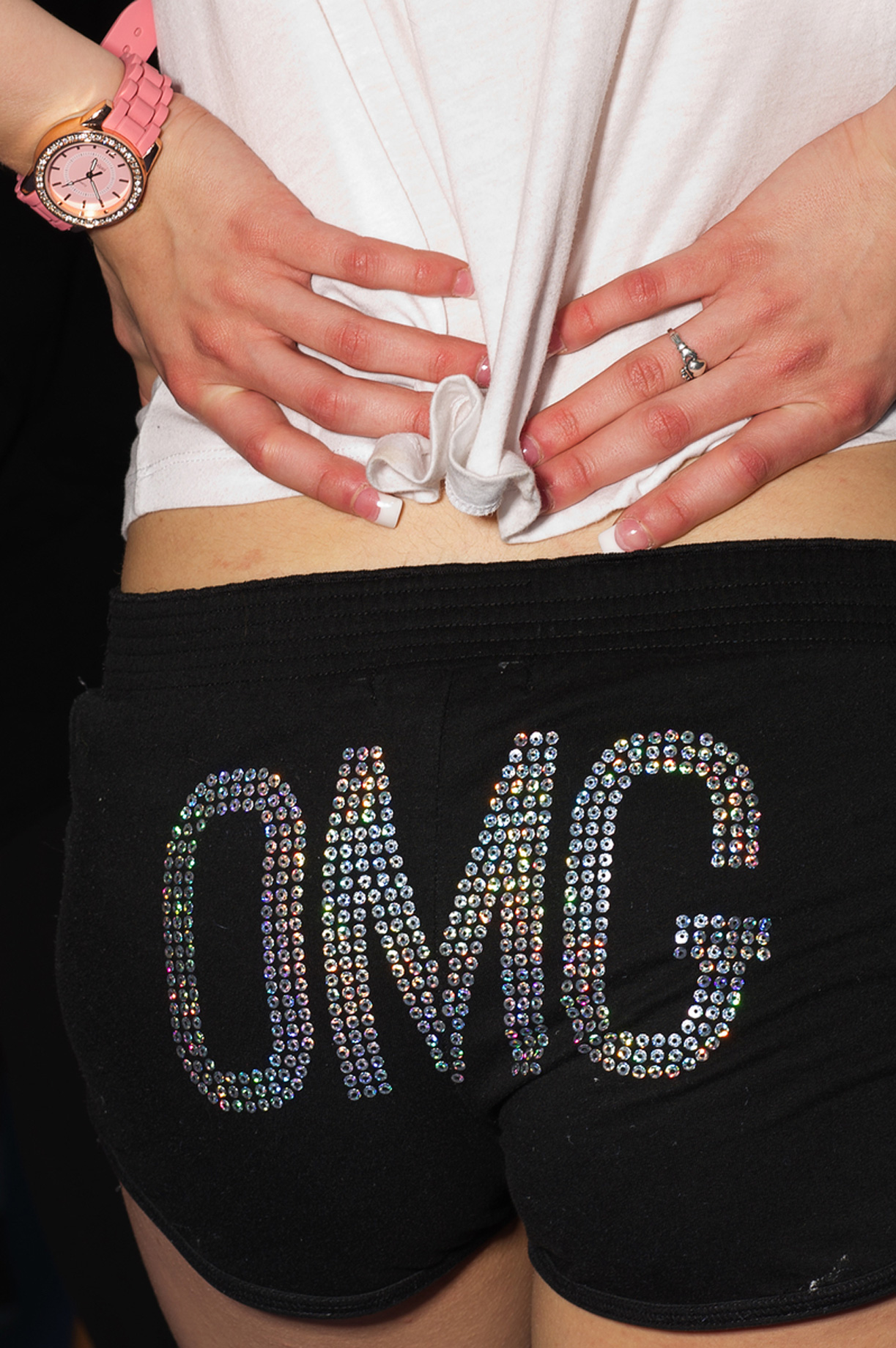
In 1994 during a seven-minute interval at the Eurovision Song Contest in Dublin a group of dancers took to the stage and proceeded to blow the audience away, including millions on television. Fronted by Michael Flatley and Jean Butler, soon to be household names, and accompanied by vibrant and relentless traditionalIrish music, this was the first public performance of the global phenomenon that would become known as Riverdance.
Now fast forward to Belfast in April, 2012. Up to 4,500 competitors took part in the Irish World Dance Championships, an event that began in more humble circumstances in Dublin in 1970 – its aim being to promote Gaelic dance culture. Since then its popularity has gone through the roof with contestants travelling from all over the world to compete.
The show is more than a dance discipline in the strict sense; the ‘look’ is also deemed important and almost an industry it itself. Contestants spray on fake-tan, carefully apply make up, attach wigs and tiaras and sport dresses that in some cases cost up to 4,000 Euro. It is an expensive environment as well as being a highly charged and extremely competitive one.
Why do they spend so much time and money on costume? To catch the judges’ attention is the common explanation. Critics claim it is over-indulgent and garish and has little to do with the reason they are there – to dance, to promote culture. Advocates insist the dance is the most important facet on which contestants are scored and that irrespective of how ornate one’s embroidered dress, these choices are entirely discretionary.
There are no hard rules governing dress sense. But it is widely accepted by those who compete and their families that unless you stand out visually then there is a danger you may be ignored.

In 1994 during a seven-minute interval at the Eurovision Song Contest in Dublin a group of dancers took to the stage and proceeded to blow the audience away, including millions on television. Fronted by Michael Flatley and Jean Butler, soon to be household names, and accompanied by vibrant and relentless traditionalIrish music, this was the first public performance of the global phenomenon that would become known as Riverdance.
Now fast forward to Belfast in April, 2012. Up to 4,500 competitors took part in the Irish World Dance Championships, an event that began in more humble circumstances in Dublin in 1970 – its aim being to promote Gaelic dance culture. Since then its popularity has gone through the roof with contestants travelling from all over the world to compete.
The show is more than a dance discipline in the strict sense; the ‘look’ is also deemed important and almost an industry it itself. Contestants spray on fake-tan, carefully apply make up, attach wigs and tiaras and sport dresses that in some cases cost up to 4,000 Euro. It is an expensive environment as well as being a highly charged and extremely competitive one.
Why do they spend so much time and money on costume? To catch the judges’ attention is the common explanation. Critics claim it is over-indulgent and garish and has little to do with the reason they are there – to dance, to promote culture. Advocates insist the dance is the most important facet on which contestants are scored and that irrespective of how ornate one’s embroidered dress, these choices are entirely discretionary.
There are no hard rules governing dress sense. But it is widely accepted by those who compete and their families that unless you stand out visually then there is a danger you may be ignored.

In 1994 during a seven-minute interval at the Eurovision Song Contest in Dublin a group of dancers took to the stage and proceeded to blow the audience away, including millions on television. Fronted by Michael Flatley and Jean Butler, soon to be household names, and accompanied by vibrant and relentless traditionalIrish music, this was the first public performance of the global phenomenon that would become known as Riverdance.
Now fast forward to Belfast in April, 2012. Up to 4,500 competitors took part in the Irish World Dance Championships, an event that began in more humble circumstances in Dublin in 1970 – its aim being to promote Gaelic dance culture. Since then its popularity has gone through the roof with contestants travelling from all over the world to compete.
The show is more than a dance discipline in the strict sense; the ‘look’ is also deemed important and almost an industry it itself. Contestants spray on fake-tan, carefully apply make up, attach wigs and tiaras and sport dresses that in some cases cost up to 4,000 Euro. It is an expensive environment as well as being a highly charged and extremely competitive one.
Why do they spend so much time and money on costume? To catch the judges’ attention is the common explanation. Critics claim it is over-indulgent and garish and has little to do with the reason they are there – to dance, to promote culture. Advocates insist the dance is the most important facet on which contestants are scored and that irrespective of how ornate one’s embroidered dress, these choices are entirely discretionary.
There are no hard rules governing dress sense. But it is widely accepted by those who compete and their families that unless you stand out visually then there is a danger you may be ignored.
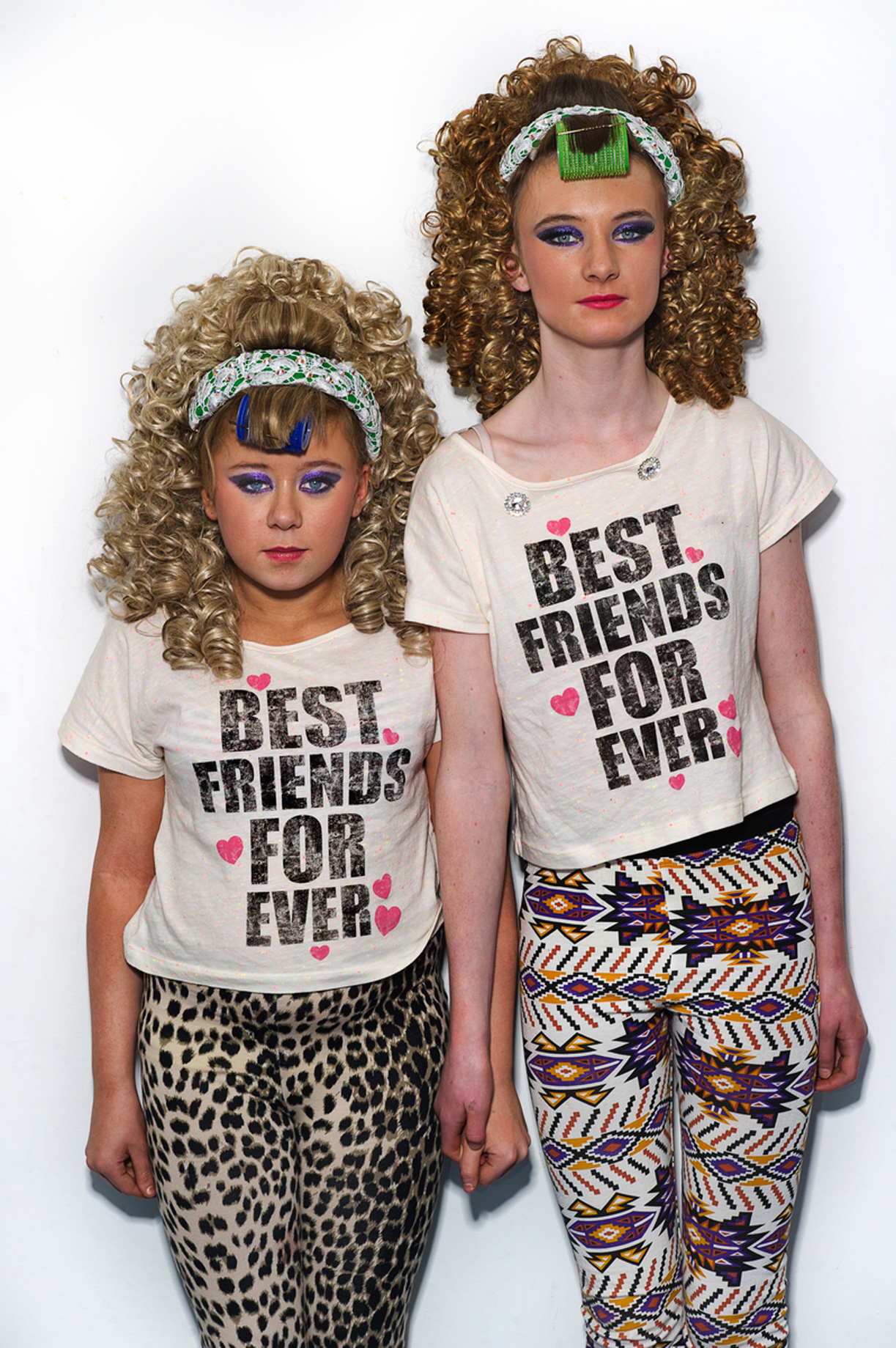
In 1994 during a seven-minute interval at the Eurovision Song Contest in Dublin a group of dancers took to the stage and proceeded to blow the audience away, including millions on television. Fronted by Michael Flatley and Jean Butler, soon to be household names, and accompanied by vibrant and relentless traditionalIrish music, this was the first public performance of the global phenomenon that would become known as Riverdance.
Now fast forward to Belfast in April, 2012. Up to 4,500 competitors took part in the Irish World Dance Championships, an event that began in more humble circumstances in Dublin in 1970 – its aim being to promote Gaelic dance culture. Since then its popularity has gone through the roof with contestants travelling from all over the world to compete.
The show is more than a dance discipline in the strict sense; the ‘look’ is also deemed important and almost an industry it itself. Contestants spray on fake-tan, carefully apply make up, attach wigs and tiaras and sport dresses that in some cases cost up to 4,000 Euro. It is an expensive environment as well as being a highly charged and extremely competitive one.
Why do they spend so much time and money on costume? To catch the judges’ attention is the common explanation. Critics claim it is over-indulgent and garish and has little to do with the reason they are there – to dance, to promote culture. Advocates insist the dance is the most important facet on which contestants are scored and that irrespective of how ornate one’s embroidered dress, these choices are entirely discretionary.
There are no hard rules governing dress sense. But it is widely accepted by those who compete and their families that unless you stand out visually then there is a danger you may be ignored.
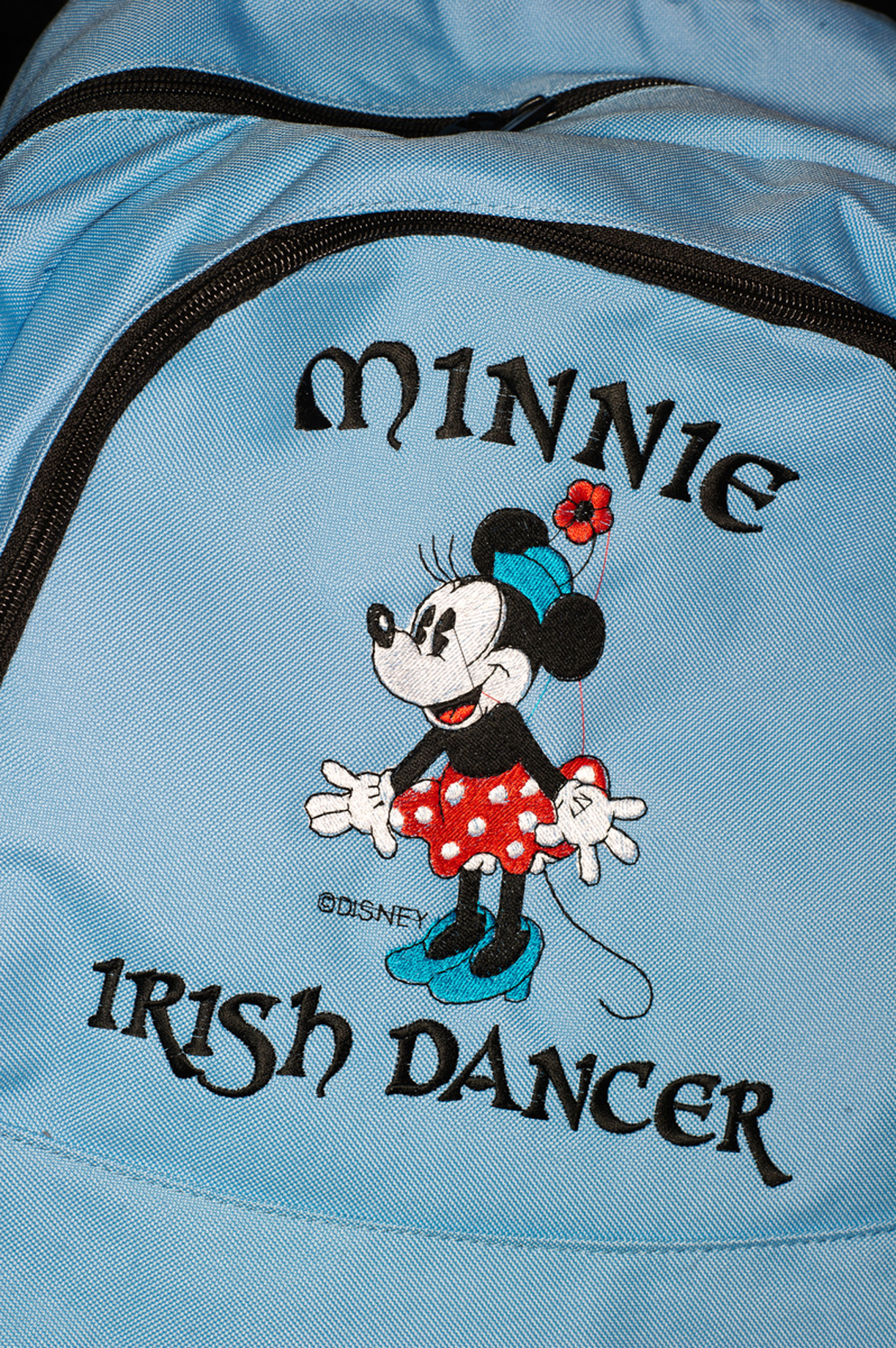
In 1994 during a seven-minute interval at the Eurovision Song Contest in Dublin a group of dancers took to the stage and proceeded to blow the audience away, including millions on television. Fronted by Michael Flatley and Jean Butler, soon to be household names, and accompanied by vibrant and relentless traditionalIrish music, this was the first public performance of the global phenomenon that would become known as Riverdance.
Now fast forward to Belfast in April, 2012. Up to 4,500 competitors took part in the Irish World Dance Championships, an event that began in more humble circumstances in Dublin in 1970 – its aim being to promote Gaelic dance culture. Since then its popularity has gone through the roof with contestants travelling from all over the world to compete.
The show is more than a dance discipline in the strict sense; the ‘look’ is also deemed important and almost an industry it itself. Contestants spray on fake-tan, carefully apply make up, attach wigs and tiaras and sport dresses that in some cases cost up to 4,000 Euro. It is an expensive environment as well as being a highly charged and extremely competitive one.
Why do they spend so much time and money on costume? To catch the judges’ attention is the common explanation. Critics claim it is over-indulgent and garish and has little to do with the reason they are there – to dance, to promote culture. Advocates insist the dance is the most important facet on which contestants are scored and that irrespective of how ornate one’s embroidered dress, these choices are entirely discretionary.
There are no hard rules governing dress sense. But it is widely accepted by those who compete and their families that unless you stand out visually then there is a danger you may be ignored.
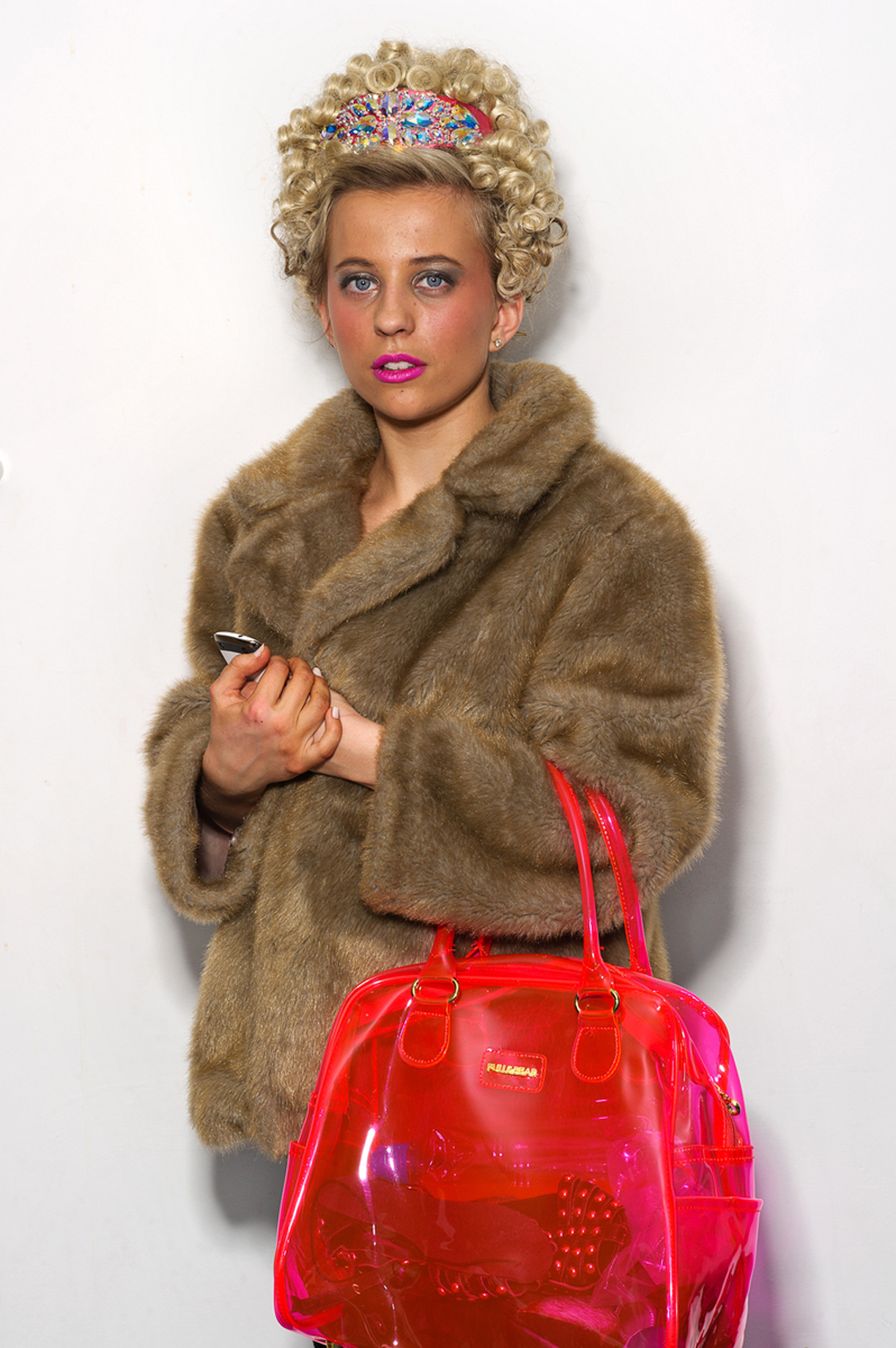
In 1994 during a seven-minute interval at the Eurovision Song Contest in Dublin a group of dancers took to the stage and proceeded to blow the audience away, including millions on television. Fronted by Michael Flatley and Jean Butler, soon to be household names, and accompanied by vibrant and relentless traditionalIrish music, this was the first public performance of the global phenomenon that would become known as Riverdance.
Now fast forward to Belfast in April, 2012. Up to 4,500 competitors took part in the Irish World Dance Championships, an event that began in more humble circumstances in Dublin in 1970 – its aim being to promote Gaelic dance culture. Since then its popularity has gone through the roof with contestants travelling from all over the world to compete.
The show is more than a dance discipline in the strict sense; the ‘look’ is also deemed important and almost an industry it itself. Contestants spray on fake-tan, carefully apply make up, attach wigs and tiaras and sport dresses that in some cases cost up to 4,000 Euro. It is an expensive environment as well as being a highly charged and extremely competitive one.
Why do they spend so much time and money on costume? To catch the judges’ attention is the common explanation. Critics claim it is over-indulgent and garish and has little to do with the reason they are there – to dance, to promote culture. Advocates insist the dance is the most important facet on which contestants are scored and that irrespective of how ornate one’s embroidered dress, these choices are entirely discretionary.
There are no hard rules governing dress sense. But it is widely accepted by those who compete and their families that unless you stand out visually then there is a danger you may be ignored.
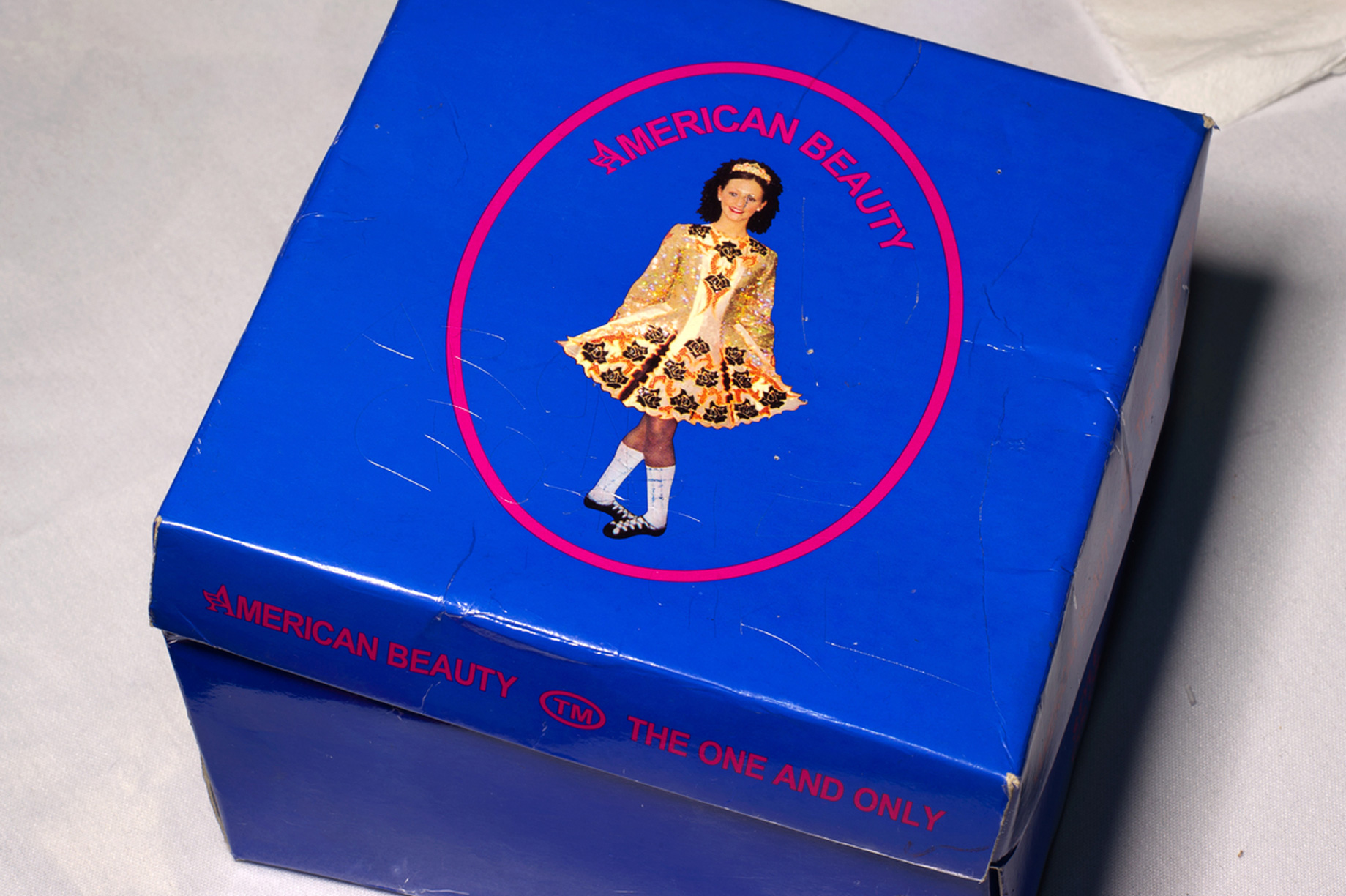
In 1994 during a seven-minute interval at the Eurovision Song Contest in Dublin a group of dancers took to the stage and proceeded to blow the audience away, including millions on television. Fronted by Michael Flatley and Jean Butler, soon to be household names, and accompanied by vibrant and relentless traditionalIrish music, this was the first public performance of the global phenomenon that would become known as Riverdance.
Now fast forward to Belfast in April, 2012. Up to 4,500 competitors took part in the Irish World Dance Championships, an event that began in more humble circumstances in Dublin in 1970 – its aim being to promote Gaelic dance culture. Since then its popularity has gone through the roof with contestants travelling from all over the world to compete.
The show is more than a dance discipline in the strict sense; the ‘look’ is also deemed important and almost an industry it itself. Contestants spray on fake-tan, carefully apply make up, attach wigs and tiaras and sport dresses that in some cases cost up to 4,000 Euro. It is an expensive environment as well as being a highly charged and extremely competitive one.
Why do they spend so much time and money on costume? To catch the judges’ attention is the common explanation. Critics claim it is over-indulgent and garish and has little to do with the reason they are there – to dance, to promote culture. Advocates insist the dance is the most important facet on which contestants are scored and that irrespective of how ornate one’s embroidered dress, these choices are entirely discretionary.
There are no hard rules governing dress sense. But it is widely accepted by those who compete and their families that unless you stand out visually then there is a danger you may be ignored.
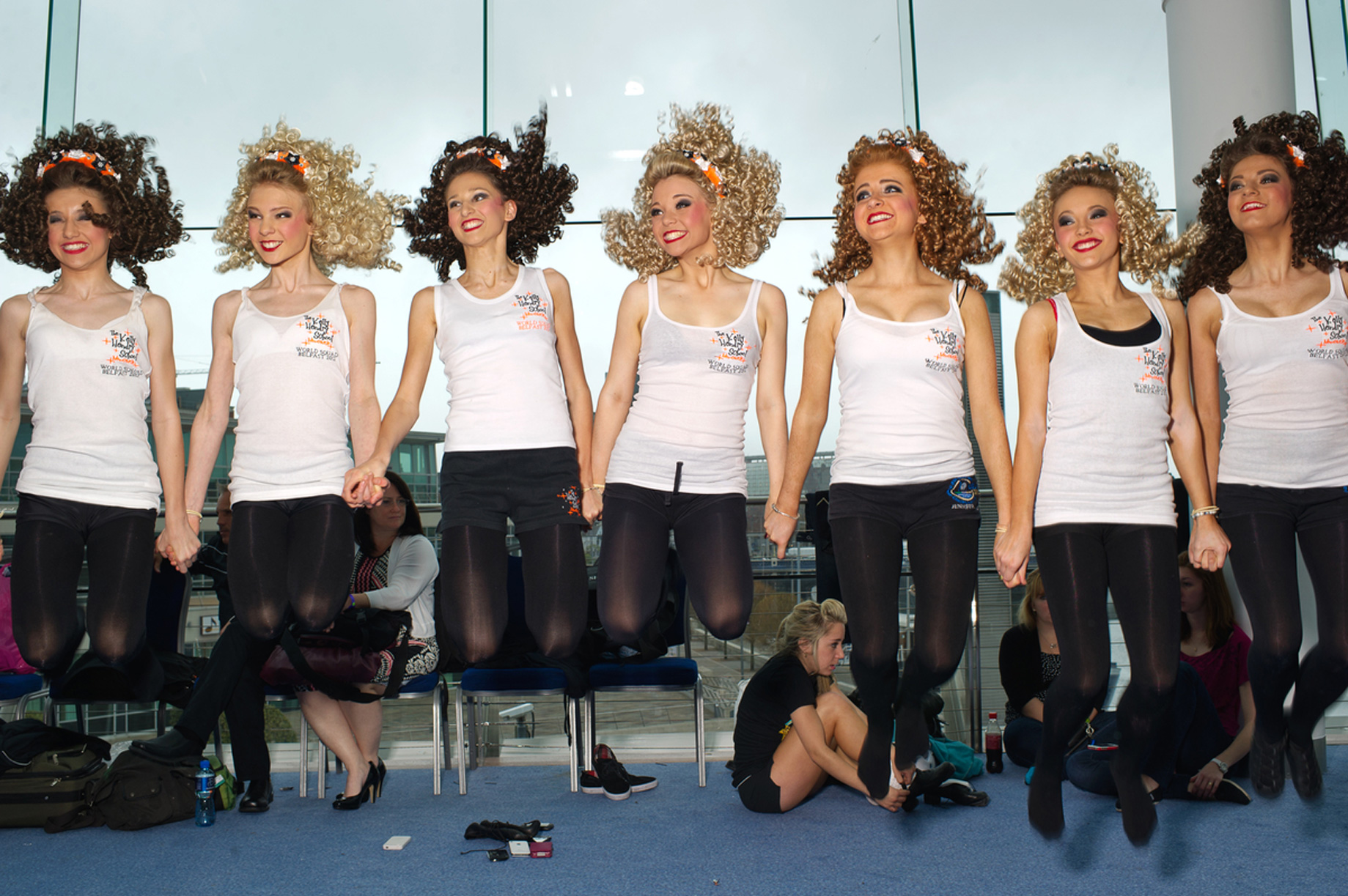
In 1994 during a seven-minute interval at the Eurovision Song Contest in Dublin a group of dancers took to the stage and proceeded to blow the audience away, including millions on television. Fronted by Michael Flatley and Jean Butler, soon to be household names, and accompanied by vibrant and relentless traditionalIrish music, this was the first public performance of the global phenomenon that would become known as Riverdance.
Now fast forward to Belfast in April, 2012. Up to 4,500 competitors took part in the Irish World Dance Championships, an event that began in more humble circumstances in Dublin in 1970 – its aim being to promote Gaelic dance culture. Since then its popularity has gone through the roof with contestants travelling from all over the world to compete.
The show is more than a dance discipline in the strict sense; the ‘look’ is also deemed important and almost an industry it itself. Contestants spray on fake-tan, carefully apply make up, attach wigs and tiaras and sport dresses that in some cases cost up to 4,000 Euro. It is an expensive environment as well as being a highly charged and extremely competitive one.
Why do they spend so much time and money on costume? To catch the judges’ attention is the common explanation. Critics claim it is over-indulgent and garish and has little to do with the reason they are there – to dance, to promote culture. Advocates insist the dance is the most important facet on which contestants are scored and that irrespective of how ornate one’s embroidered dress, these choices are entirely discretionary.
There are no hard rules governing dress sense. But it is widely accepted by those who compete and their families that unless you stand out visually then there is a danger you may be ignored.
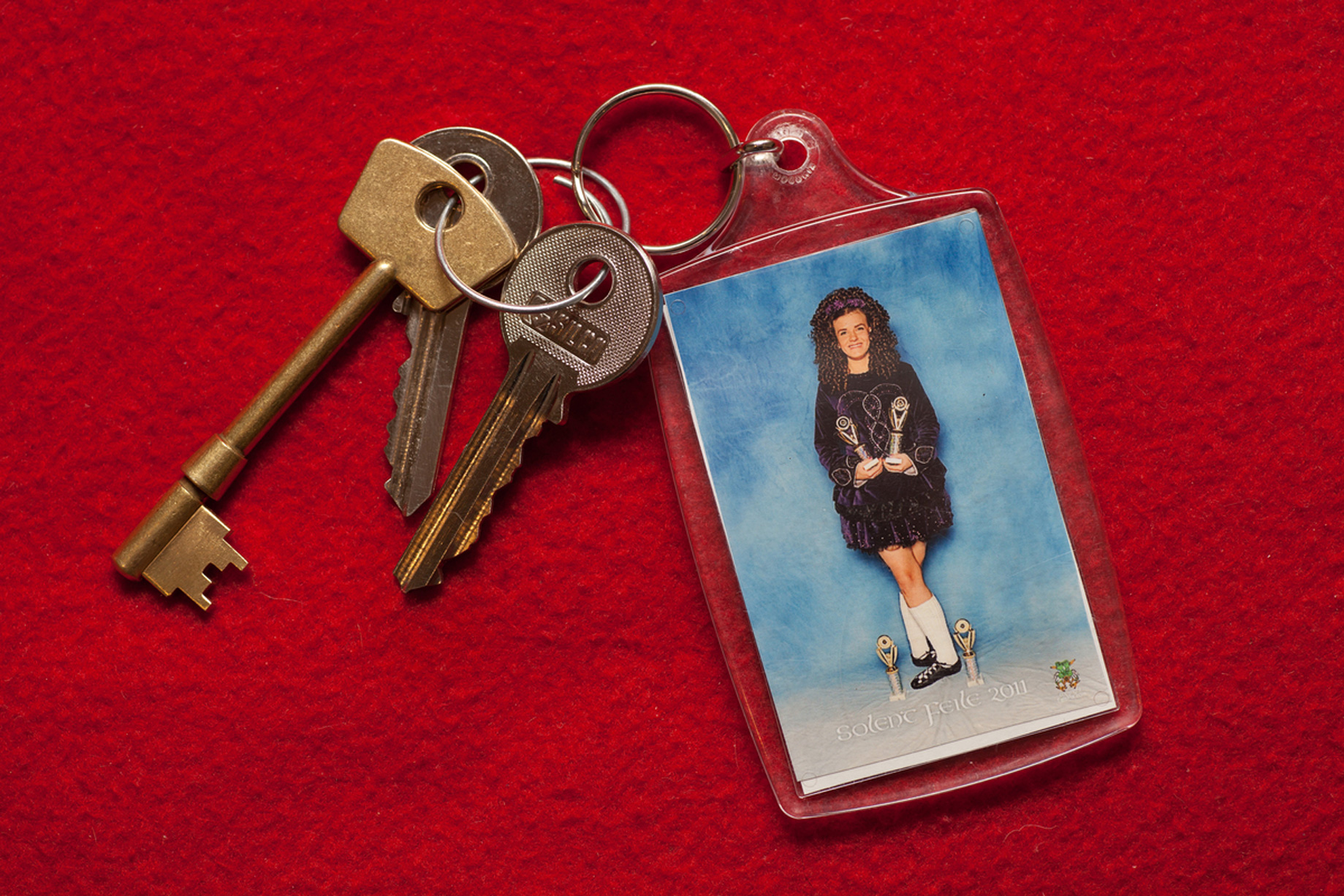
In 1994 during a seven-minute interval at the Eurovision Song Contest in Dublin a group of dancers took to the stage and proceeded to blow the audience away, including millions on television. Fronted by Michael Flatley and Jean Butler, soon to be household names, and accompanied by vibrant and relentless traditionalIrish music, this was the first public performance of the global phenomenon that would become known as Riverdance.
Now fast forward to Belfast in April, 2012. Up to 4,500 competitors took part in the Irish World Dance Championships, an event that began in more humble circumstances in Dublin in 1970 – its aim being to promote Gaelic dance culture. Since then its popularity has gone through the roof with contestants travelling from all over the world to compete.
The show is more than a dance discipline in the strict sense; the ‘look’ is also deemed important and almost an industry it itself. Contestants spray on fake-tan, carefully apply make up, attach wigs and tiaras and sport dresses that in some cases cost up to 4,000 Euro. It is an expensive environment as well as being a highly charged and extremely competitive one.
Why do they spend so much time and money on costume? To catch the judges’ attention is the common explanation. Critics claim it is over-indulgent and garish and has little to do with the reason they are there – to dance, to promote culture. Advocates insist the dance is the most important facet on which contestants are scored and that irrespective of how ornate one’s embroidered dress, these choices are entirely discretionary.
There are no hard rules governing dress sense. But it is widely accepted by those who compete and their families that unless you stand out visually then there is a danger you may be ignored.
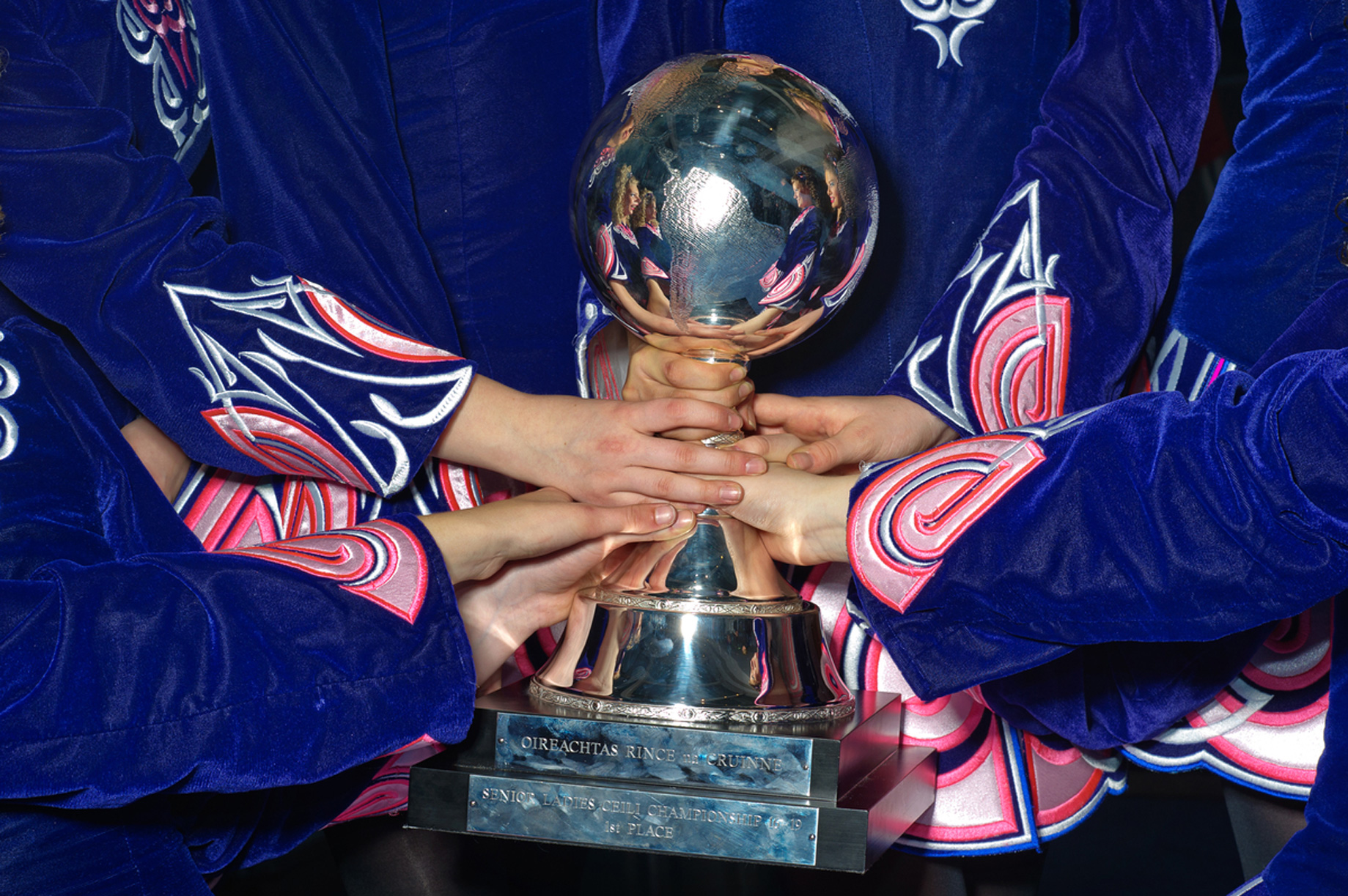
In 1994 during a seven-minute interval at the Eurovision Song Contest in Dublin a group of dancers took to the stage and proceeded to blow the audience away, including millions on television. Fronted by Michael Flatley and Jean Butler, soon to be household names, and accompanied by vibrant and relentless traditionalIrish music, this was the first public performance of the global phenomenon that would become known as Riverdance.
Now fast forward to Belfast in April, 2012. Up to 4,500 competitors took part in the Irish World Dance Championships, an event that began in more humble circumstances in Dublin in 1970 – its aim being to promote Gaelic dance culture. Since then its popularity has gone through the roof with contestants travelling from all over the world to compete.
The show is more than a dance discipline in the strict sense; the ‘look’ is also deemed important and almost an industry it itself. Contestants spray on fake-tan, carefully apply make up, attach wigs and tiaras and sport dresses that in some cases cost up to 4,000 Euro. It is an expensive environment as well as being a highly charged and extremely competitive one.
Why do they spend so much time and money on costume? To catch the judges’ attention is the common explanation. Critics claim it is over-indulgent and garish and has little to do with the reason they are there – to dance, to promote culture. Advocates insist the dance is the most important facet on which contestants are scored and that irrespective of how ornate one’s embroidered dress, these choices are entirely discretionary.
There are no hard rules governing dress sense. But it is widely accepted by those who compete and their families that unless you stand out visually then there is a danger you may be ignored.
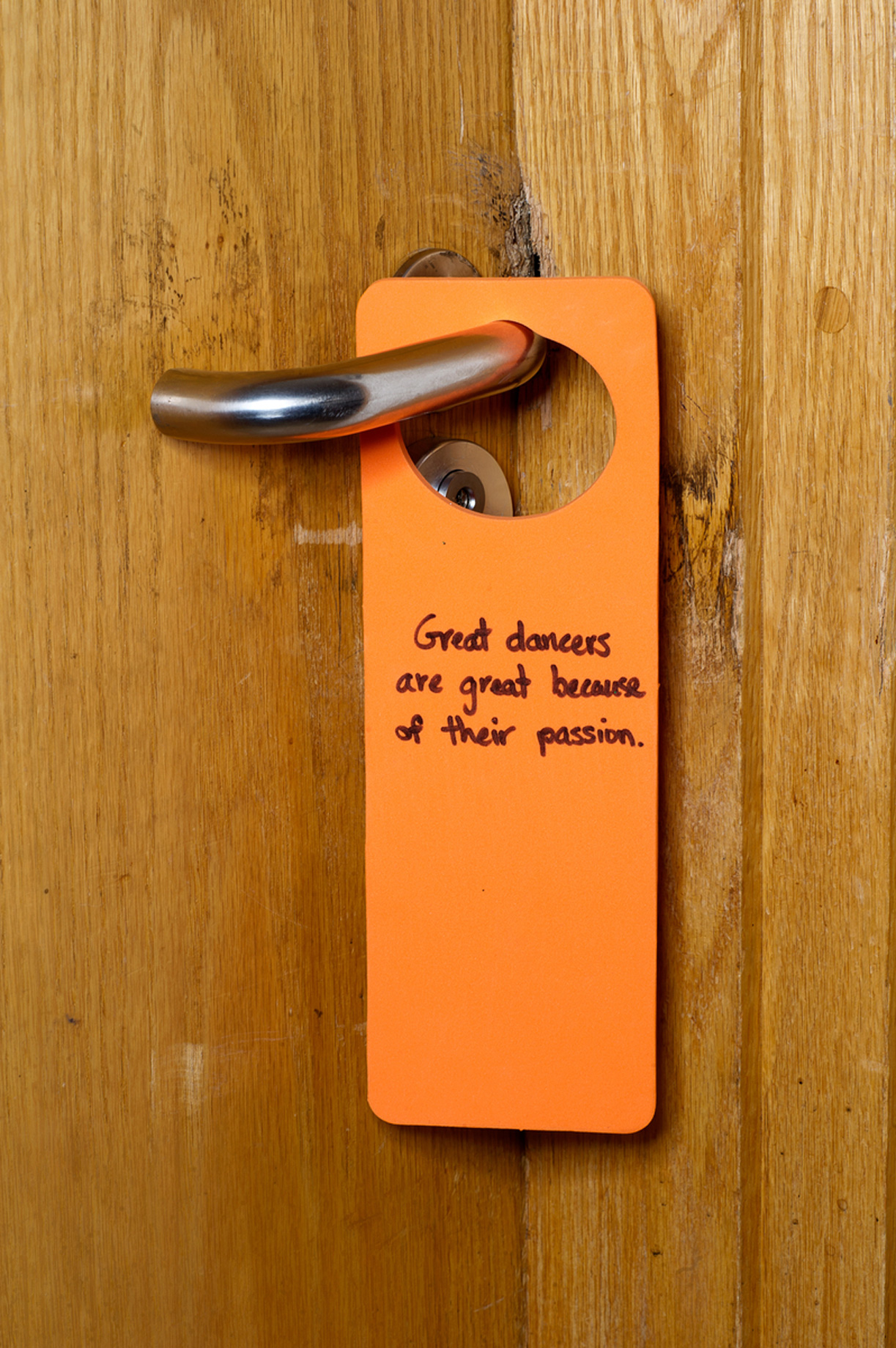
In 1994 during a seven-minute interval at the Eurovision Song Contest in Dublin a group of dancers took to the stage and proceeded to blow the audience away, including millions on television. Fronted by Michael Flatley and Jean Butler, soon to be household names, and accompanied by vibrant and relentless traditionalIrish music, this was the first public performance of the global phenomenon that would become known as Riverdance.
Now fast forward to Belfast in April, 2012. Up to 4,500 competitors took part in the Irish World Dance Championships, an event that began in more humble circumstances in Dublin in 1970 – its aim being to promote Gaelic dance culture. Since then its popularity has gone through the roof with contestants travelling from all over the world to compete.
The show is more than a dance discipline in the strict sense; the ‘look’ is also deemed important and almost an industry it itself. Contestants spray on fake-tan, carefully apply make up, attach wigs and tiaras and sport dresses that in some cases cost up to 4,000 Euro. It is an expensive environment as well as being a highly charged and extremely competitive one.
Why do they spend so much time and money on costume? To catch the judges’ attention is the common explanation. Critics claim it is over-indulgent and garish and has little to do with the reason they are there – to dance, to promote culture. Advocates insist the dance is the most important facet on which contestants are scored and that irrespective of how ornate one’s embroidered dress, these choices are entirely discretionary.
There are no hard rules governing dress sense. But it is widely accepted by those who compete and their families that unless you stand out visually then there is a danger you may be ignored.

In 1994 during a seven-minute interval at the Eurovision Song Contest in Dublin a group of dancers took to the stage and proceeded to blow the audience away, including millions on television. Fronted by Michael Flatley and Jean Butler, soon to be household names, and accompanied by vibrant and relentless traditionalIrish music, this was the first public performance of the global phenomenon that would become known as Riverdance.
Now fast forward to Belfast in April, 2012. Up to 4,500 competitors took part in the Irish World Dance Championships, an event that began in more humble circumstances in Dublin in 1970 – its aim being to promote Gaelic dance culture. Since then its popularity has gone through the roof with contestants travelling from all over the world to compete.
The show is more than a dance discipline in the strict sense; the ‘look’ is also deemed important and almost an industry it itself. Contestants spray on fake-tan, carefully apply make up, attach wigs and tiaras and sport dresses that in some cases cost up to 4,000 Euro. It is an expensive environment as well as being a highly charged and extremely competitive one.
Why do they spend so much time and money on costume? To catch the judges’ attention is the common explanation. Critics claim it is over-indulgent and garish and has little to do with the reason they are there – to dance, to promote culture. Advocates insist the dance is the most important facet on which contestants are scored and that irrespective of how ornate one’s embroidered dress, these choices are entirely discretionary.
There are no hard rules governing dress sense. But it is widely accepted by those who compete and their families that unless you stand out visually then there is a danger you may be ignored.
Between The Jigs and The Reels































